Schneider Shorts of 6 October 2023 – what really happened to deleted US professor, a scientist in France needs IT assistance, rigorous peer review at work, with hand-made spectra, sneaked references and many retractions, for Nobelists, papermills and other cheaters, big and small.
Table of Discontent
Science Elites
- You do some screening – Sabine Szunerits needs expert help
Scholarly Publishing
- Hand-made science – lovely handcrafted spectra by M Bilal Tahir and others!
- Rigorous peer review – at Frontiers in Public Health, part 1
- Perception of threat – at Frontiers in Public Health, part 2
- The pivotal roles of miRNAs – oncology review of retracted papermill fraud
- Sneaked references – what Crossref gets from predatory publishers
Retraction Watchdogging
- To minimize the stress levels – Shaker Mousa’s revealing retractions
- Original uncropped version from imager – 10th retraction credits Nobelist Gregg Semenza
- Despite internal data validation – Gary Dunbar retracts paper he fixed with fraudulent correction
- Editor-in-Chief no longer has confidence – German journal retracts Egyptian papermill fraud
- My laptop was formatted – rare retraction at Toxicology Reports
- Third time unlucky – concrete problems with 3rd correction
Science Elites
You do some screening
Meet Sabine Szunerits, Austria-born professor of chemistry at the University of Lille in France. Quite recently, Dr Szunerits was appointed Knight of the French National Order of the Legion of Honour, because she discovered cures for many infections and other diseases, all with nanotechnology. She is also on a lookout for someone to help her with data integrity analysis because of her recent PubPeer issues.
There are almost 30 Szunerits’ papers on PubPeer, often about image reuse inside and between papers. Like here:
Chengnan Li , Ran Ye , Julie Bouckaert , Amaia Zurutuza , Djamel Drider , Tetiana Dumych , Solomiya Paryzhak , Volodymyr Vovk , Rostyslav O. Bilyy , Sorin Melinte , Musen Li , Rabah Boukherroub , Sabine Szunerits Flexible Nanoholey Patches for Antibiotic-Free Treatments of Skin Infections ACS Applied Materials & Interfaces (2017) doi: 10.1021/acsami.7b12949
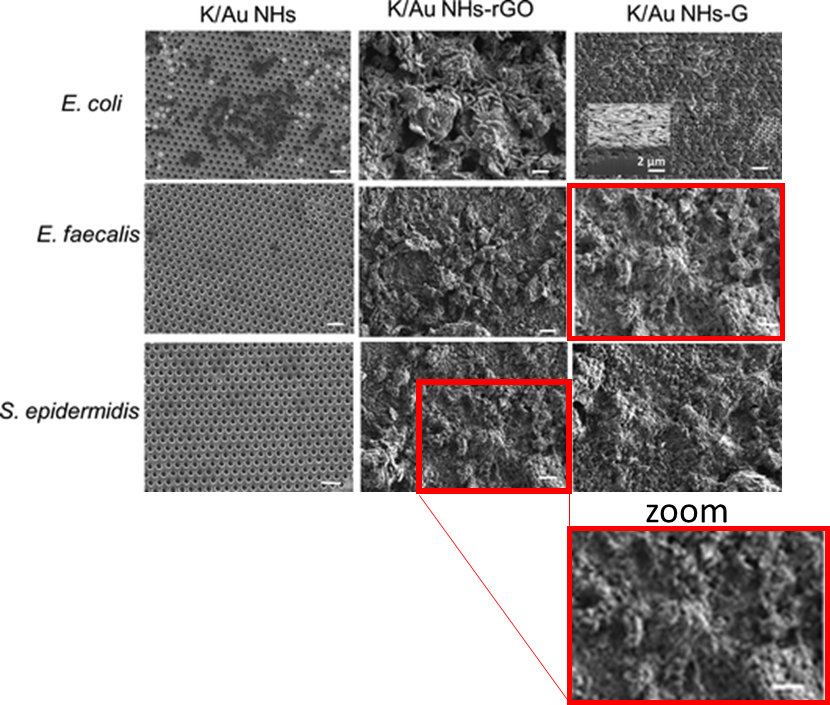
On PubPeer, Szunerits claimed that “the figure was overlayed by the other” during publication process. Another mix-up here:
Anna Voronova , Alexandre Barras, Valérie Plaisance , Valerie Pawlowski , Rabah Boukherroub, Amar Abderrahmani, Sabine Szunerits Anti-aggregation effect of carbon quantum dots on diabetogenic and beta-cell cytotoxic amylin and beta amyloid heterocomplexes Nanoscale (2022) doi: 10.1039/d2nr03173f

An even trickier case of image re-use:
Volodymyr Turcheniuk , Viktoria Raks , Rahaf Issa , Ian R. Cooper , Peter J. Cragg , Roxana Jijie , Nicoleta Dumitrascu , Lyuba I. Mikhalovska , Alexandre Barras , Vladimir Zaitsev , Rabah Boukherroub, Sabine Szunerits Antimicrobial activity of menthol modified nanodiamond particles Diamond and Related Materials (2015) doi: 10.1016/j.diamond.2014.12.002

Szunerits’ verdict:
“indeed the images got mixed but. However it does not change anything on the final results of the paper.”
Without affecting any of the final results, the same image appeared in another paper from same lab, Khanal et al 2015, this time described as “ND-Man3“, with Szunerits proclaiming: “the scientific context of the paper does not change.” Worse, a nanodiamond image from this Turcheniuk et al 2015 paper resurfaced as “ND-mannan” in 2016 (Turcheniuk et al 2016) and again in 2021, to treat COVID-19!
Rostyslav Bilyy , Quentin Pagneux , Nathan François , Galyna Bila , Roman Grytsko , Yuri Lebedin , Alexandre Barras , Jean Dubuisson, Sandrine Belouzard , Karin Séron , Rabah Boukherroub, Sabine Szunerits Rapid Generation of Coronaviral Immunity Using Recombinant Peptide Modified Nanodiamonds Pathogens (2021) doi: 10.3390/pathogens10070861
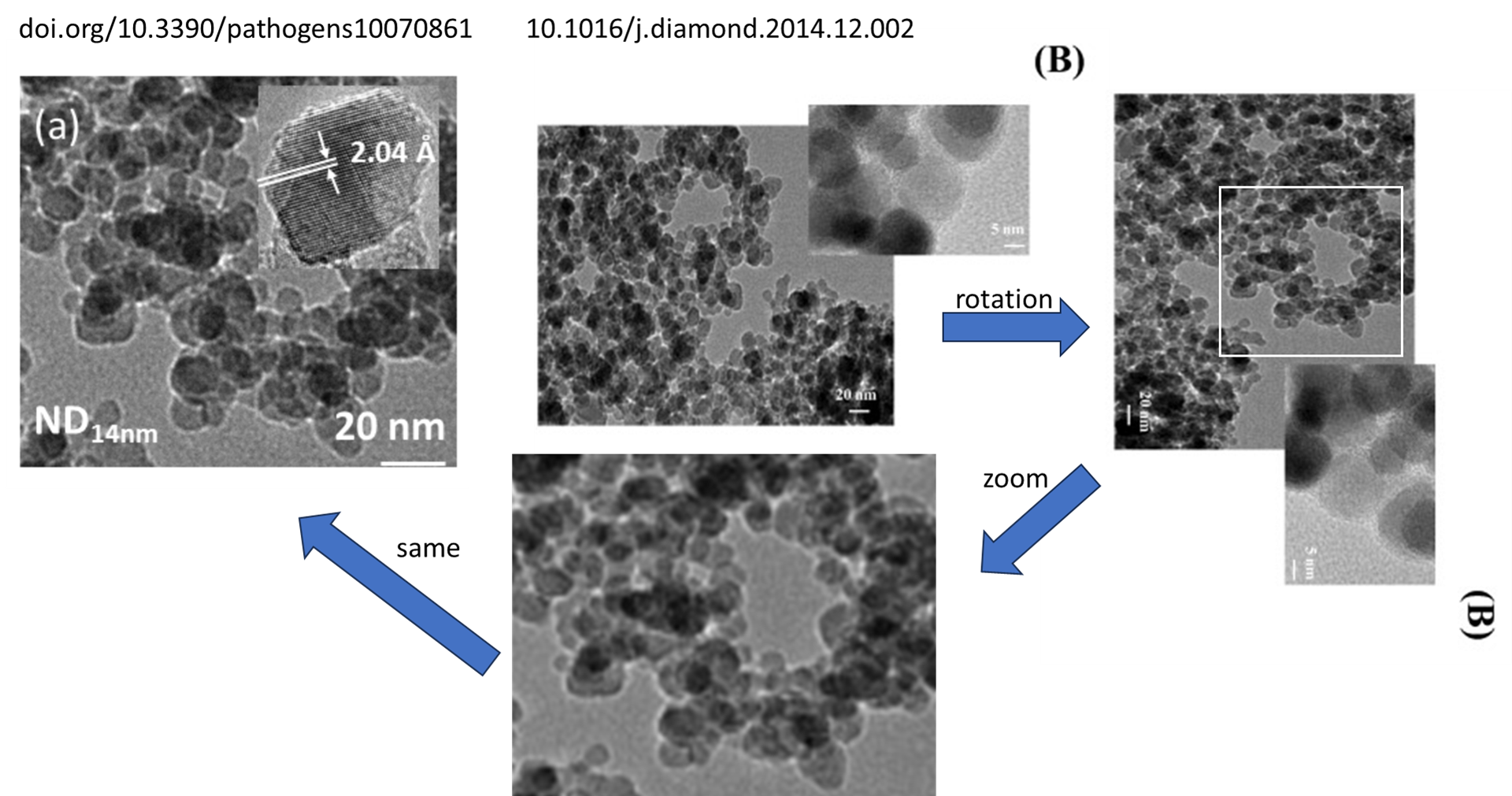
Szunerits’ reaction:
“I wish I would have your skills to see these errors when checking results. For me they look the same!!“
By the way, Lille researchers are famous throughout the world for discovering a cure for COVID-19, pardon, a method to get €5 million from world’s richest man.
The secret COVID-19 cure of Pasteur Lille
There is a miracle drug for COVID-19, but it is secret. Enterprising researchers at Institute Pasteur in Lille ask for €5 million.
Sometimes, spectra got reused:
Kostiantyn Turcheniuk , Tetiana Dumych , Rostyslav Bilyy , Volodymyr Turcheniuk , Julie Bouckaert , Volodymyr Vovk , Valentyna Chopyak , Vladimir Zaitsev , Pascal Mariot , Natasha Prevarskaya , Rabah Boukherroub, Sabine Szunerits Plasmonic photothermal cancer therapy with gold nanorods/reduced graphene oxide core/shell nanocomposites RSC Advances (2016) doi: 10.1039/c5ra24662h
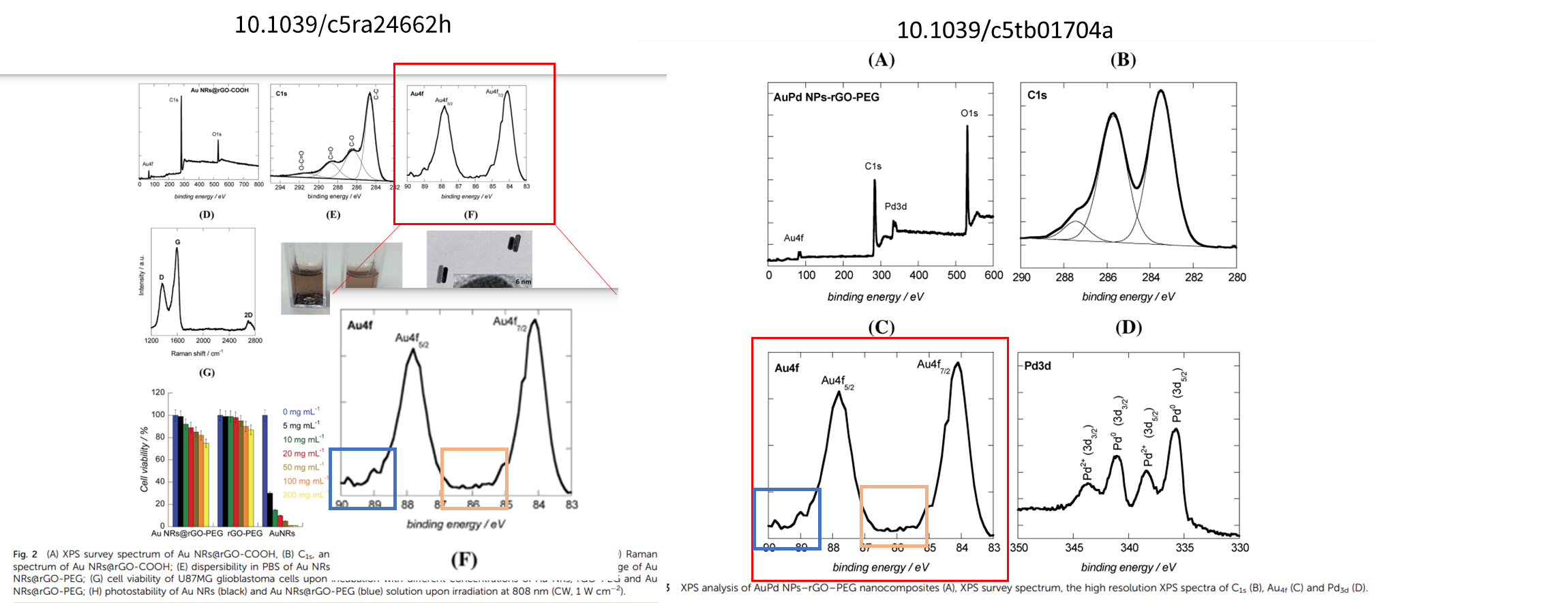
AuPd NPs–rGO–PEG (gold/palladium alloy) in 10.1039/c5tb01704a
Au NRs@rGO-COOH (gold nanorods) in 10.1039/c5ra24662h“
Szunerits was unconvinced:
“I tried to overlayed the XPS and for me there differences, on the left hand side for example, no?“
How about such a copy-paste spectra figure, and you may recognise Szunerits’ coauthor, the legendary French mega-cheater, Jolanda Spadavecchia!
Oleksandr Zagorodko , Jolanda Spadavecchia , Aritz Yanguas Serrano , Iban Larroulet , Amaia Pesquera , Amaia Zurutuza , Rabah Boukherroub , Sabine Szunerits Highly Sensitive Detection of DNA Hybridization on Commercialized Graphene-Coated Surface Plasmon Resonance Interfaces Analytical Chemistry (2014) doi: 10.1021/ac502705n
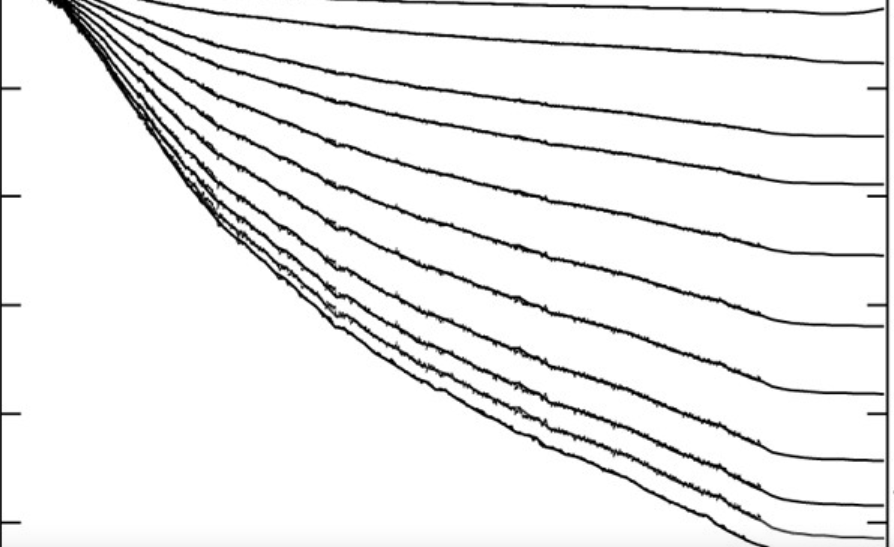
As a PubPeer commenter noted, hat Figure 4B is supposed to show “a series of curves showing changes in SPR signal over time at different DNA concentrations.” Yet: “Most of the plots, however, appear to show the same data, simply multiplied by a different constant, with the pattern of noise repeated at all concentrations.” More fabrications in this paper:
Kostiantyn Turcheniuk, Charles-Henri Hage , Jolanda Spadavecchia , Aritz Yanguas Serrano , Iban Larroulet , Amaia Pesquera , Amaia Zurutuza , Mariano Gonzalez Pisfil , Laurent Héliot , Julie Boukaert , Rabah Boukherroub , Sabine Szunerits Plasmonic photothermal destruction of uropathogenic E. coli with reduced graphene oxide and core/shell nanocomposites of gold nanorods/reduced graphene oxide Journal of Materials Chemistry B (2015) doi: 10.1039/c4tb01760a
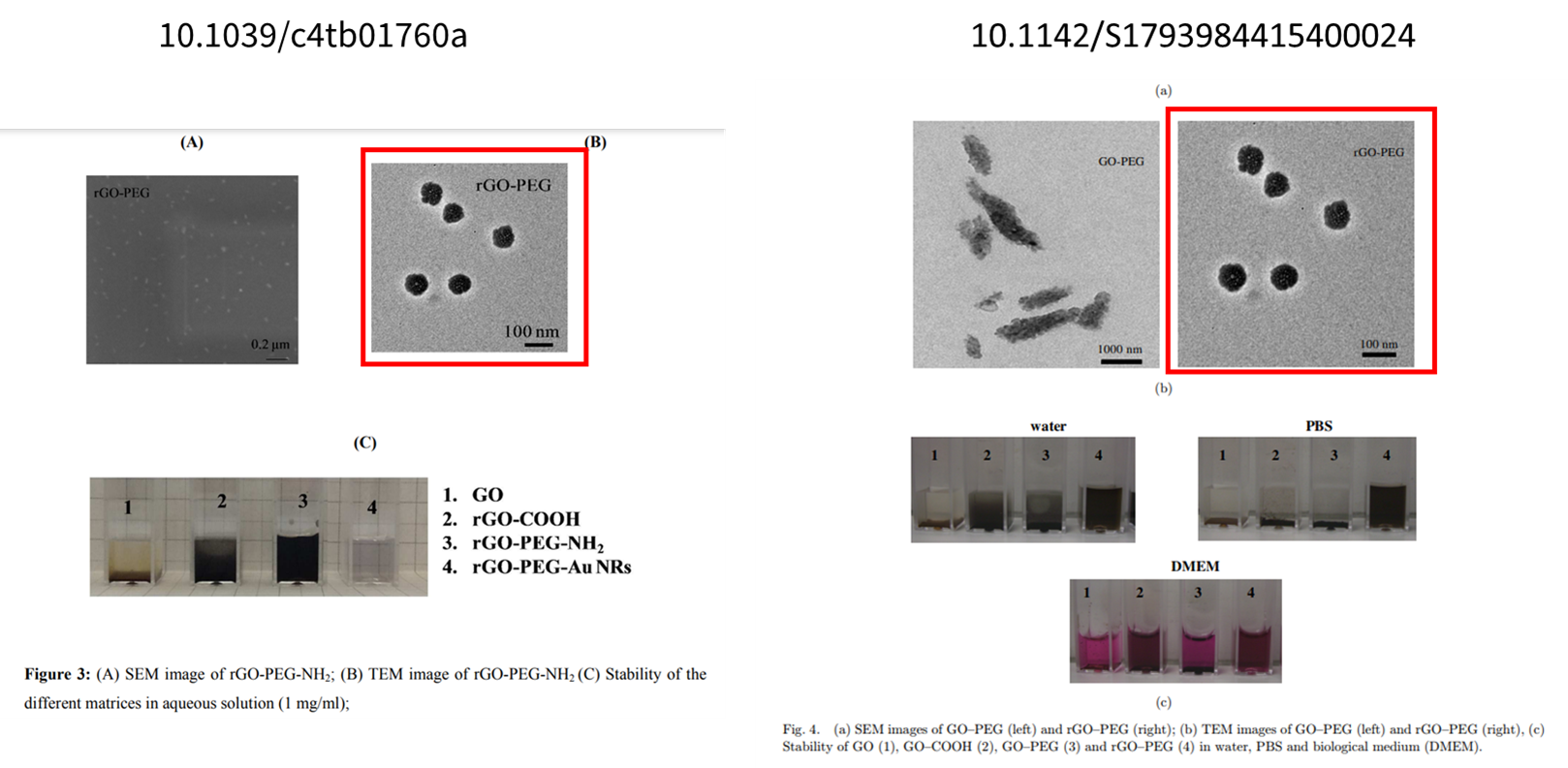

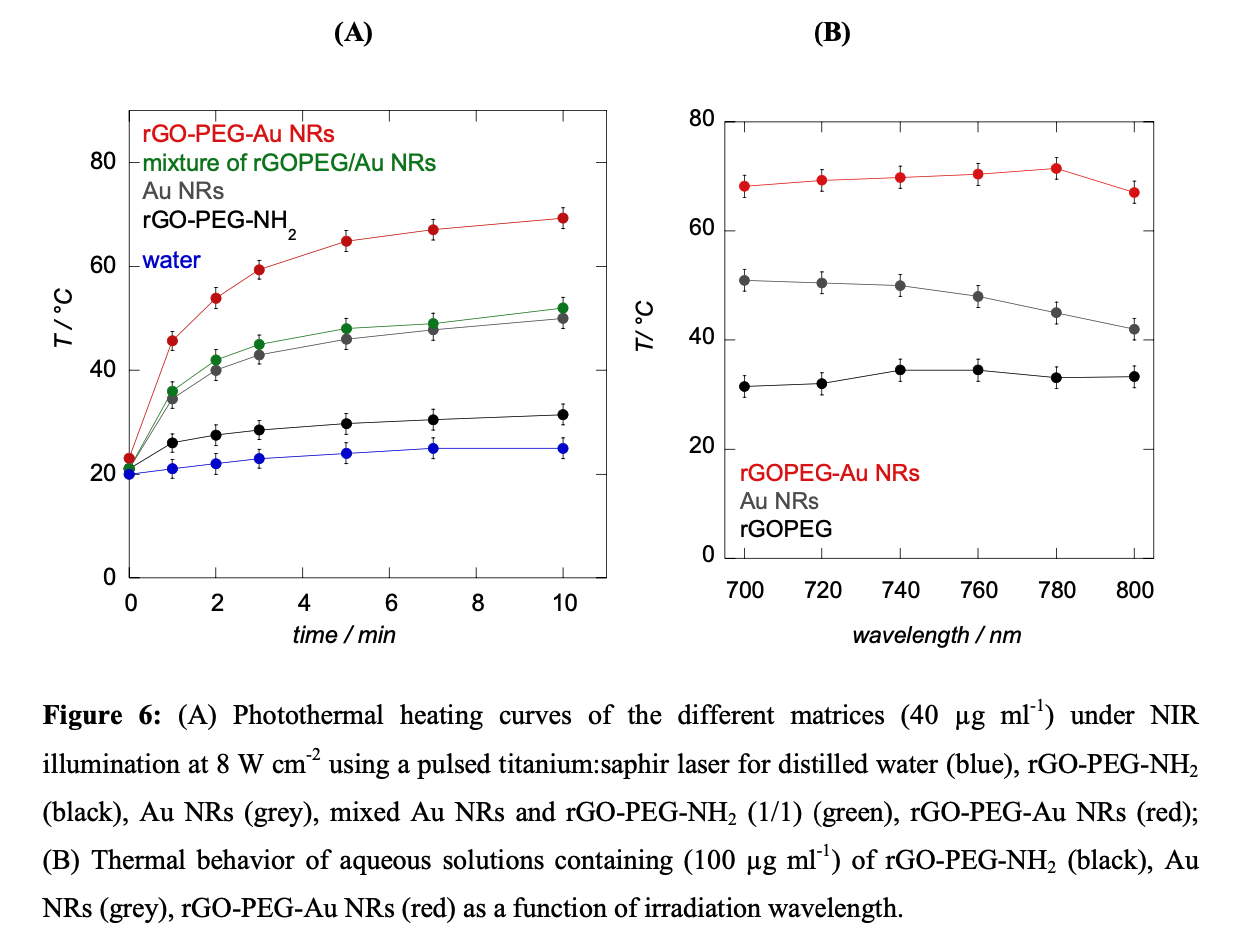



Szunerits found no problems except of faulty graphics software, and added:
“What is most importantI think is that the message is not effect.”
The message has not effect here as well:
Alexandre Barras , Quentin Pagneux , Famara Sane , Qi Wang , Rabah Boukherroub , Didier Hober , Sabine Szunerits High Efficiency of Functional Carbon Nanodots as Entry Inhibitors of Herpes Simplex Virus Type 1 ACS Applied Materials & Interfaces (2016) doi: 10.1021/acsami.6b01681

Szunerits explained on PubPeer that because “C1s bands are different“, concerns were misplaced.
There is much more of this on PubPeer, Next to Sunerits, a common name on all of these problematic papers is her fellow nanotechnology professor at Lille, Rabah Boukherroub. As Szunerits told me, he is her “coworker in next office“. From Boukherroub’s own lab:
Elizaveta Sviridova , Alexandre Barras, Ahmed Addad , Evgenii Plotnikov , Antonio Di Martino , Dominique Deresmes , Ksenia Nikiforova , Marina Trusova , Sabine Szunerits, Olga Guselnikova , Pavel Postnikov , Rabah Boukherroub Surface modification of carbon dots with tetraalkylammonium moieties for fine tuning their antibacterial activity Biomaterials Advances (2022) doi: 10.1016/j.msec.2022.112697
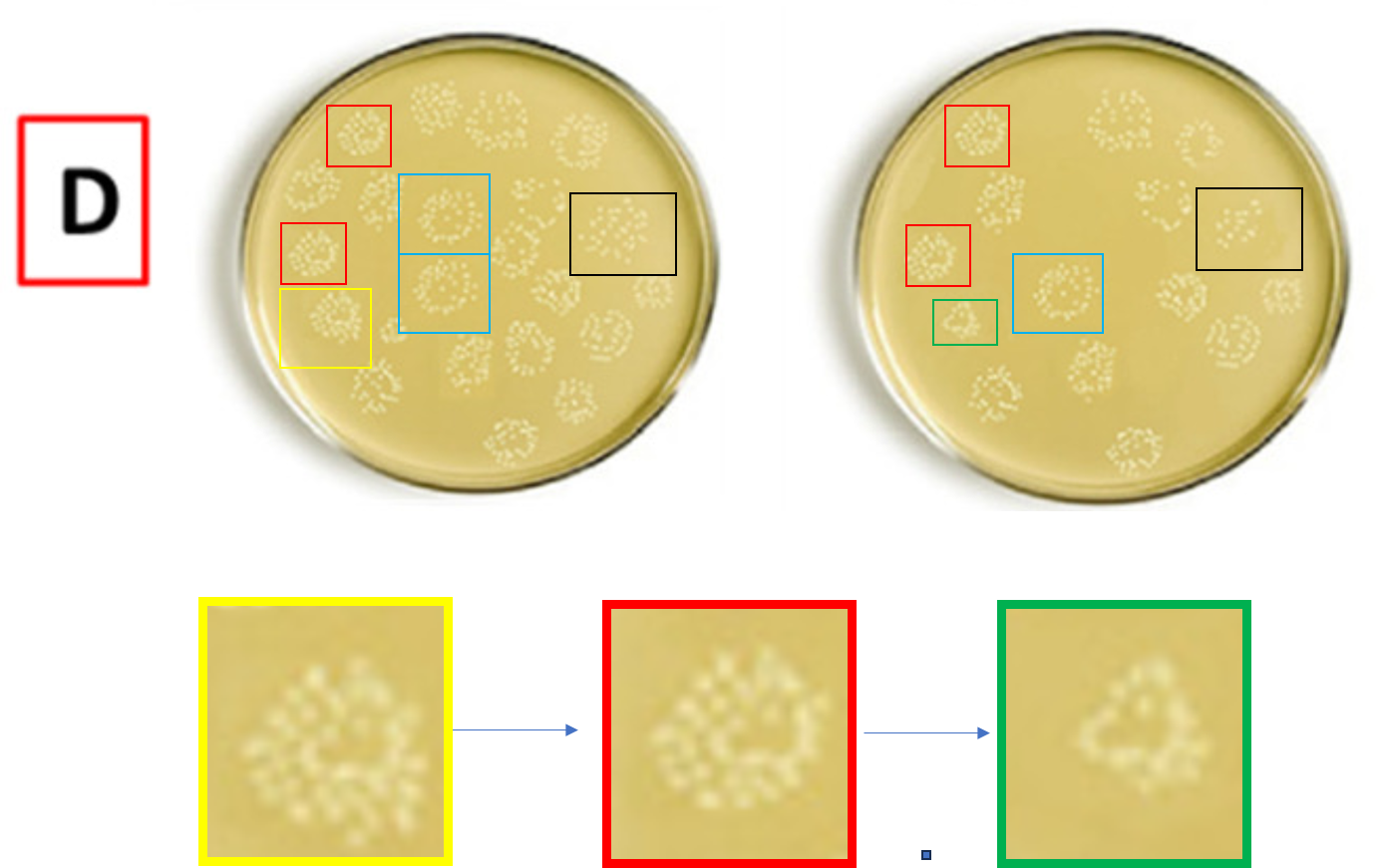
As for Boukherroub’s own research ethics, well, check PubPeer for who else he published bad science with. First: Mika Sillanpää, the Finnish papermiller in Denmark! With Sillanpää, Boukherroub joined Iranian papermill fabrications with fake data and nonsense references. Second, also with a huge PubPeer record: Suman L. Jain, the nano-forger from India! And here are Jain, Boukherroub and Szunerits together, with duplicated spectra:
Amer Al-Nafiey , Anurag Kumar , Malika Kumar , Ahmed Addad , Brigitte Sieber , Sabine Szunerits , Rabah Boukherroub , Suman L. Jain Nickel oxide nanoparticles grafted on reduced graphene oxide (rGO/NiO) as efficient photocatalyst for reduction of nitroaromatics under visible light irradiation Journal of Photochemistry and Photobiology A: Chemistry (2017)
doi: 10.1016/j.jphotochem.2016.12.023

I wrote to Szunerits on 1 October 2023. She replied immediately, and took full responsibility as lead author:
“Indeed I take these concerns very serious and look at each data carefully. I already send 3 erratum demands as wrong images have indeed been used as some data got mixed up. Some other flagged papers are not correct and I will answer them step by step.
In fact I would love we have the possibility before submitting a paper as supervisors to be able to use your skills an see where probably wrong images were used etc. Do you think there is any change as this would be more helpful then making erratums.”
I replied wondering if she would merely replace the figures if some confidential IT service allowed her to detect these fabrications pre-submission, as opposed to say, actually investigating the fraud in her lab. I didn’t tell Szunerits that there is indeed such a commercial service already, Proofig by Dror Kolodkin-Gal:
Proofig – the Kolodkin-Gal family business
“Don’t let online controversies and aggressive blogs easily ruin everything you’ve worked for to build your reputation […] Whether the image issue is innocent or intentional, the outcome is still the same. Bloggers will attack that publication with image issues, which will damage your reputation and may even lead to a costly investigation. We are…
This is how Szunerits replied:
“What about we try out. The next 4 papers I do send to you as pdf file and you do some screening by whoever you want and we see what it gives? This is a good case study and will show the value
Then I send the next 4 without IT service to see the verdict?”
What???
Scholarly Publishing
Hand-made science
Have a look what passes peer review in very respectable science journals. First, a study in an Elsevier journal with impact factor 8.6, led by Belgian professor Bart Van der Bruggen, and cited 131 times:
M. Bilal Tahir, M. Sagir Carbon nanodots and rare metals (RM = La, Gd, Er) doped tungsten oxide nanostructures for photocatalytic dyes degradation and hydrogen production Separation and Purification Technology (2019) doi: 10.1016/j.seppur.2018.07.029


Yes, those spectra are hand-drawn. Badly even. But peer-reviewed! The journal boasts a “25% Acceptance Rate”, so what do they reject? Actual science?
Literally same hand here, but in another Elsevier journal with impact factor of 13.6 and a US professor as Editor-in-Chief, Zhen (Jason) He. 14% acceptance rate here even. This is the kind of science editors expect:
M.B. Tahir, M. Sagir , K. Shahzad Removal of acetylsalicylate and methyl-theobromine from aqueous environment using nano-photocatalyst WO3-TiO2 @g-C3N4 composite Journal of Hazardous Materials (2019) doi: 10.1016/j.jhazmat.2018.09.055

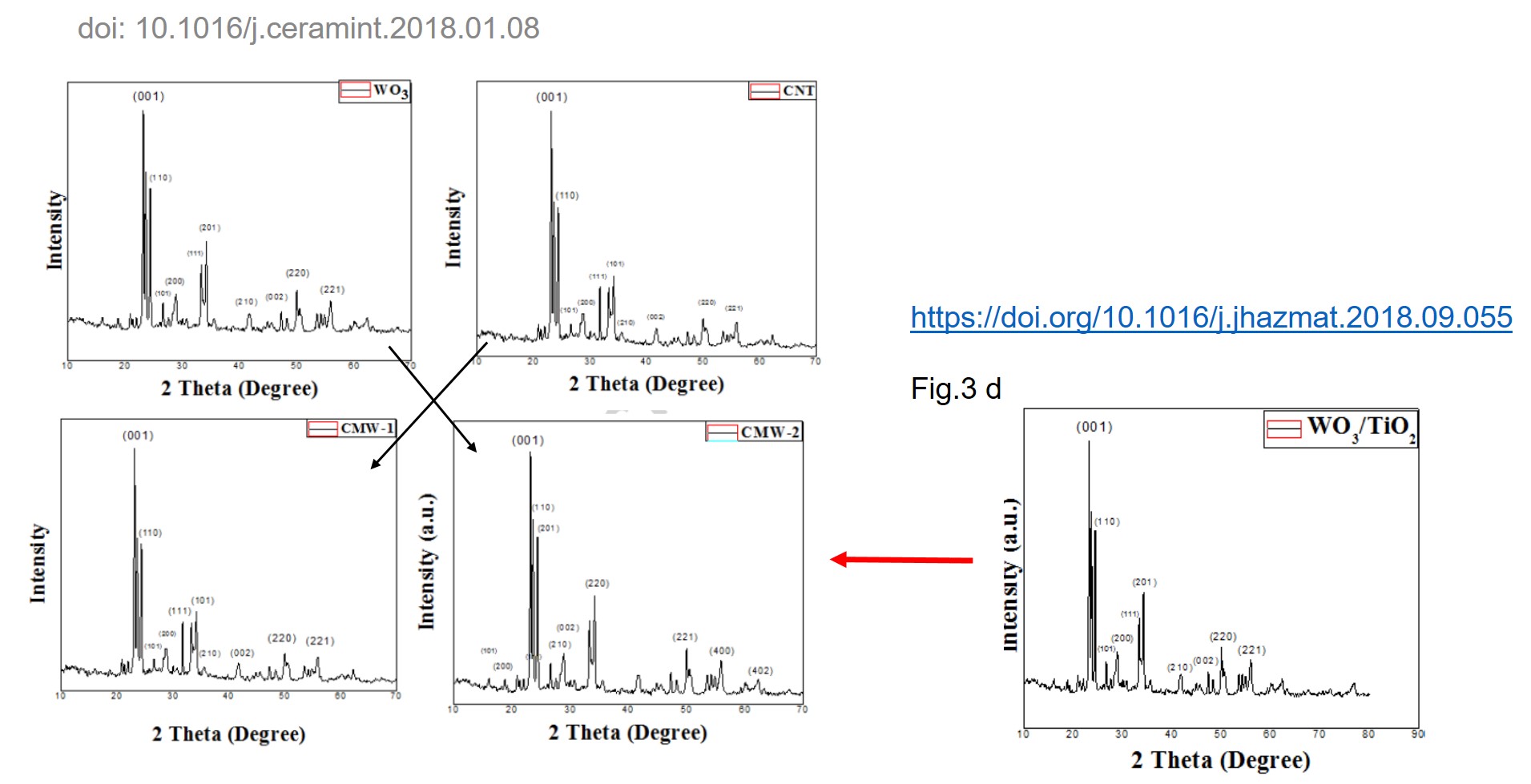
Elsevier announced to me to investigate. There will be a lot, because every paper that Pakistani assistant professor Muhammad Bilal Tahir published seems to contain a forgery. Much is already on PubPeer, and look, you may remember this Elsevier journal (Impact factor 9.4) and its former Editor-in-Chief, the German professor Dirk-Uwe Sauer:
Suhaima Aftab , M.B. Tahir , M.S. Tahir , M. Sagir Fabrication of NiCo2Se4@ NiWO4 nanocomposites for high performance supercapacitor applications Journal of Energy Storage (2022) doi: 10.1016/j.est.2022.106111

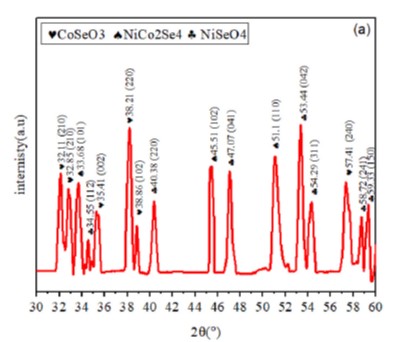
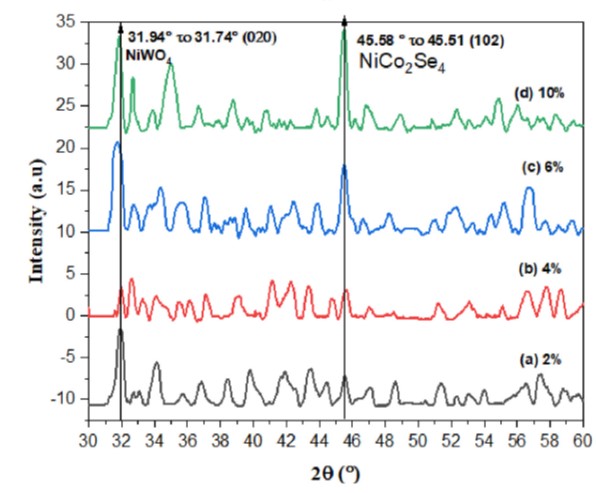
Beautiful drawings, and such a nice fabrication indeed, and peer reviewed to boot! I am sure Prof Dr Sauer gave Tahir a star, just like in kindergarten.
Maybe stop accepting submissions, Herr Prof Dr Sauer?
Who needs science if you can have a 75 paper strong special edition by Afrand and Karimi? A guest post by Alexander Magazinov.
Other publishers are also affected. Here Wiley’s Hindawi:
M.B. Tahir , Tahir Iqbal , Habiba Kiran , Ali Hasan Insighting role of reduced graphene oxide in BiVO4 nanoparticles for improved photocatalytic hydrogen evolution and dyes degradation International Journal of Energy Research (2019) doi: 10.1002/er.4443

This is what Springer Nature got:
Salma Aman , Muhammad Bilal Tahir , Naseeb Ahmad Study of Europium substituted spinel ferrites for microwave devices Journal of Materials Science Materials in Electronics (2022) doi: 10.1007/s10854-022-08990-4

How these lines were produced?”

Produced by hand, and peer-reviewed by a [****]. In the same journal, but without Tahir:
B. Anandha Priya , T. Sivakumar , M. Parthibavarman , P. Venkateswari Design and fabrication of NiS decorating 2D ultra-thin TiO2 thin film nanocomposites with enhanced photocatalytic hydrogen evolution activity Journal of Materials Science Materials in Electronics (2023) doi: 10.1007/s10854-023-09873-y
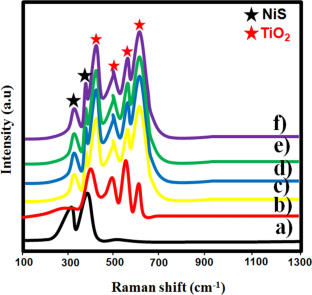
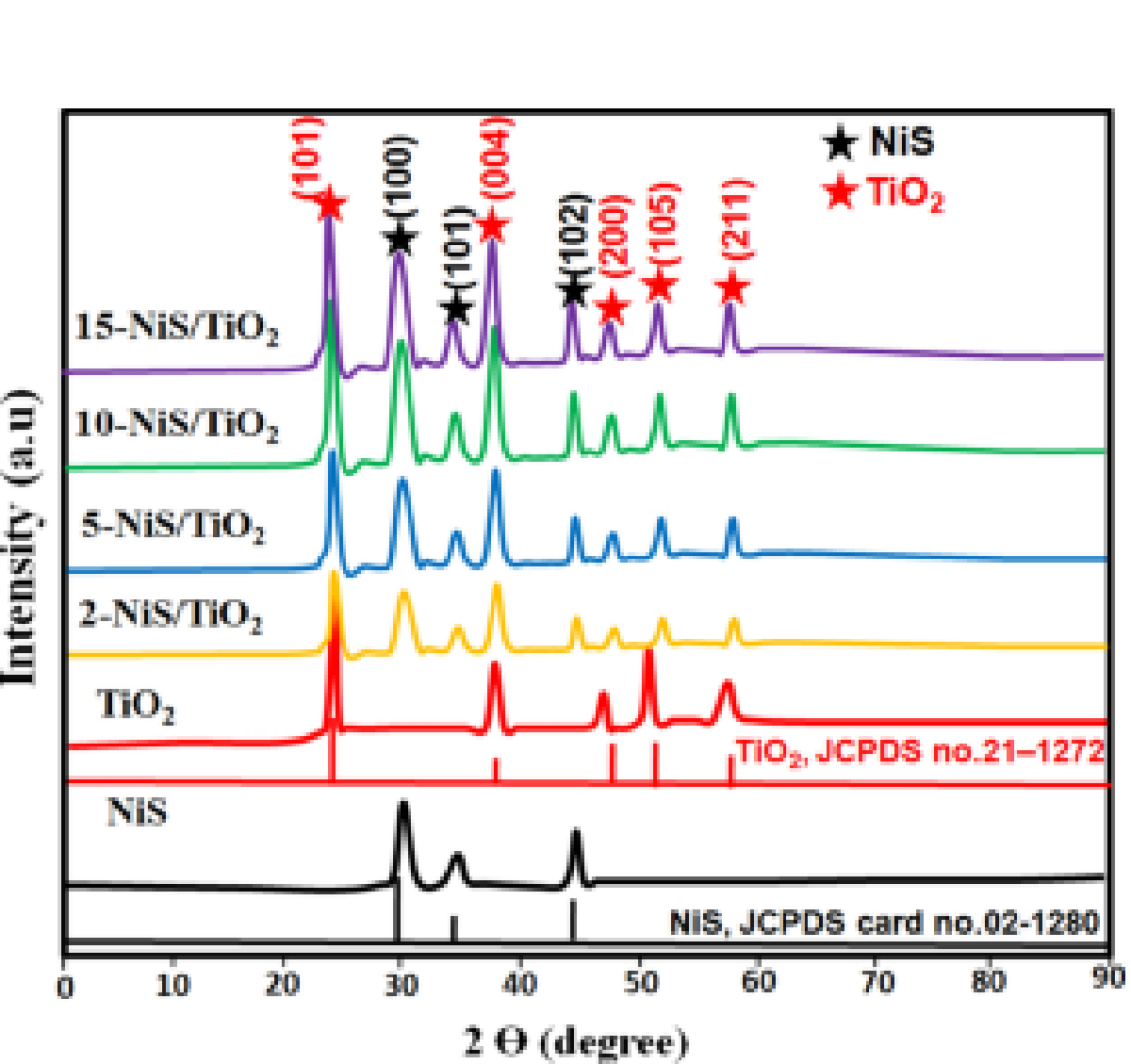
Look at the noise of Figure 7:
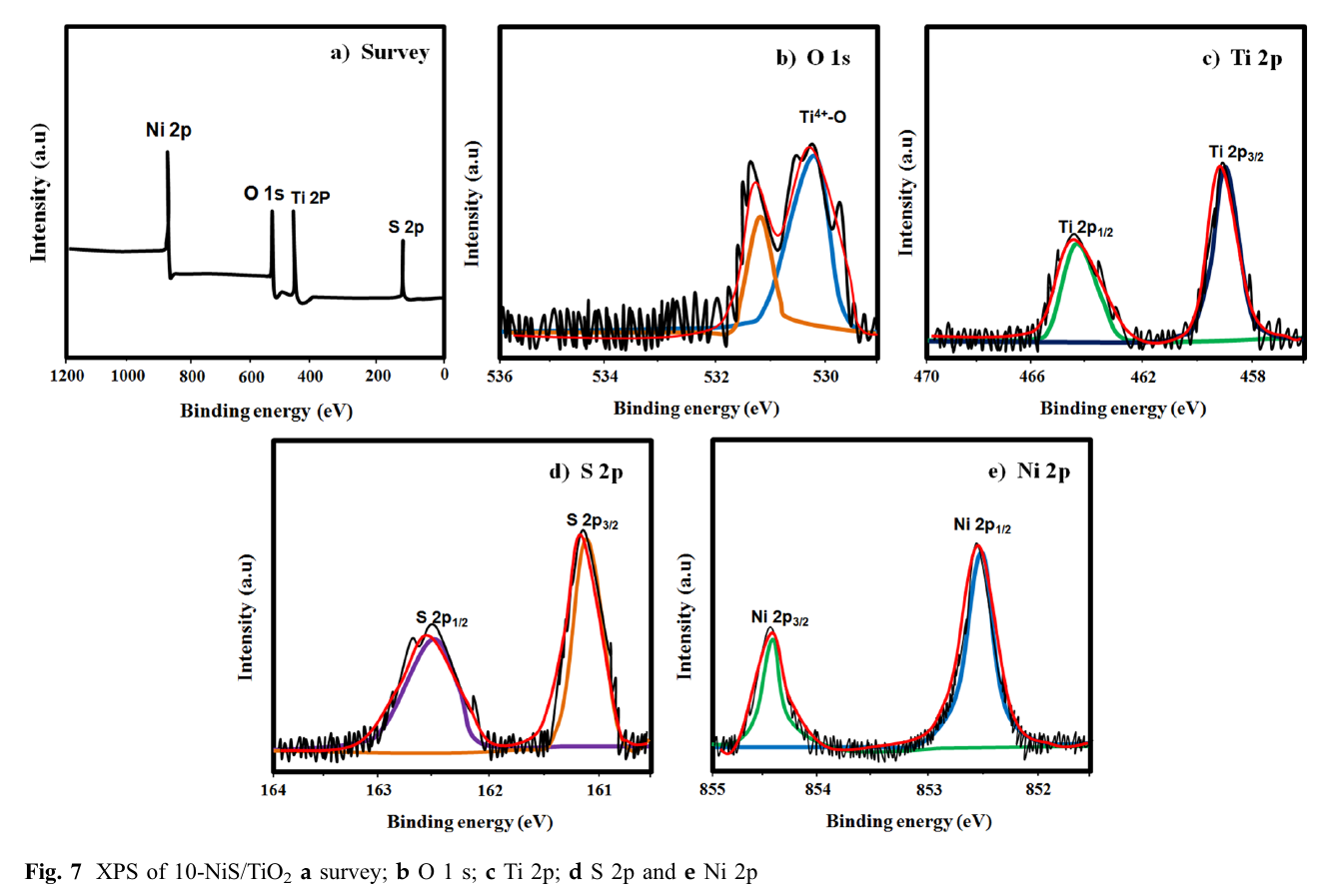
“Very unusual noise that indeed looks rather hand-drawn.”

Again, same authors, same journal, what were the Editor-in-Chief, the Canadian professor Safa O. Kasap and other editors actually thinking? Do they even know what their journal peer-reviews and publishes? This paper contains, next to hand-drawn and duplicated spectra, inappropriate citations to someone called M. Parthibavarman:
B. Anandha Priya , T. Sivakumar , P. Venkateswari Controlled loading of MnS2 on porous TiO2 nanosheets for enhanced photocatalytic hydrogen evolution Journal of Materials Science Materials in Electronics (2022) doi: 10.1007/s10854-022-07839-0
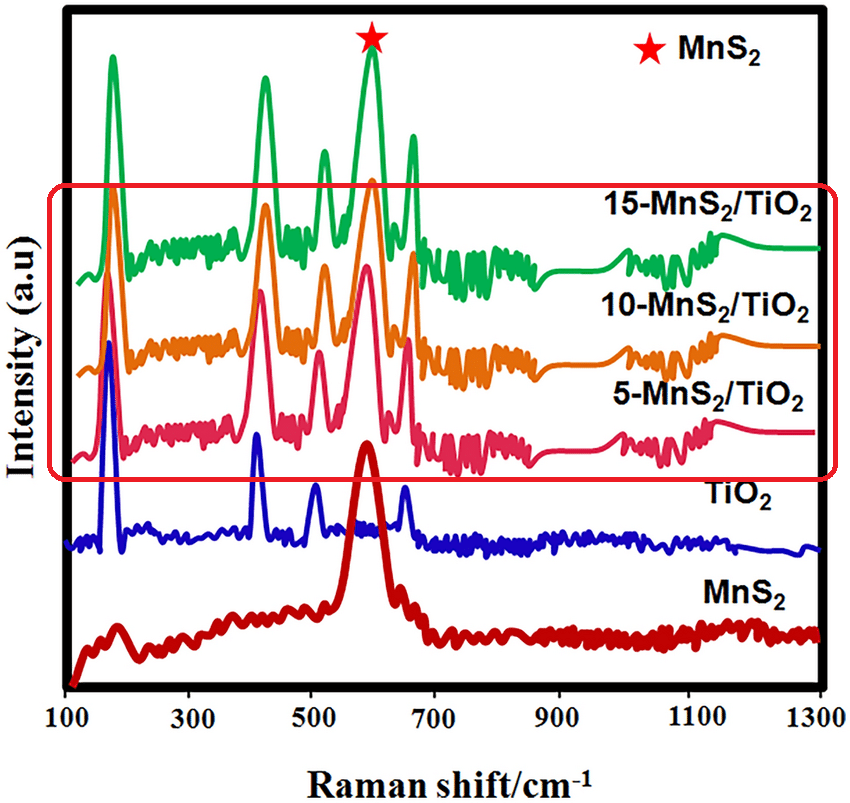

A colleague googled this fellow Parthibavarman, and found this, in the same journal:
M. Jayashree , M. Parthibavarman , R. BoopathiRaja , S. Prabhu , R. Ramesh Ultrafine MnO2/graphene based hybrid nanoframeworks as high-performance flexible electrode for energy storage applications Journal of Materials Science Materials in Electronics (2020) doi: 10.1007/s10854-020-03254-5

Maybe the spectra MUST be hand-drawn these days?
Rigorous peer review
More on the topic of peer review. As everyone should know, Frontiers operates the bestest peer review in the universe:
“Rigorous peer review
Editorial decisions at Frontiers are guided by clear acceptance and rejection criteria during a single-blind, rigorous peer review. Editorial independence of acceptance decisions is assured by the involvement of external experts as editors and reviewers. Our in-house publishing professionals quality-control and monitor the process, may reject manuscripts at any point during the review and validate final editorial decisions to ensure our quality standards and policies are being adhered to.”
There are indeed no limits to the Frontiers peer review rigorousness:
Shiwei Jiang , Hongwei Hou A Secure Artificial Intelligence-Enabled Critical Sars Crisis Management Using Random Sigmoidal Artificial Neural Networks Frontiers in Public Health (2022) doi: 10.3389/fpubh.2022.901294
An original research article about AI and COVID-19 pandemic, part of a Research Topic (i.e., Special Issue) edited by who I am sure must be world’s greatest scholarly experts in the fields of Public Health, AI, Blockchain and other buzzwords. But what is this, in the paper’s text:
“In (22), many of the disorders have multiple odontogenic keratocysts. A 12-year-old female youngster had several odontogenic keratocysts. The studies found no other anomalies indicative of a condition.”
22. Mody RN, Bhoosreddy AR. Multiple odontogenic keratocysts: a case report. Ann Dent. (1995) 54:41–3.
Smut Clyde found many more weird sentences and references, discussing “traditional Chinese medicine therapy of […] allergic rhinitis“, “high-dose-rate (HDR) brachytherapy“, “organochlorine pesticides” in Nigerian vegetables, and, to indicate where the paper came from, “a treatment as well as the technology of domestic sewage to improve the rural surroundings.“
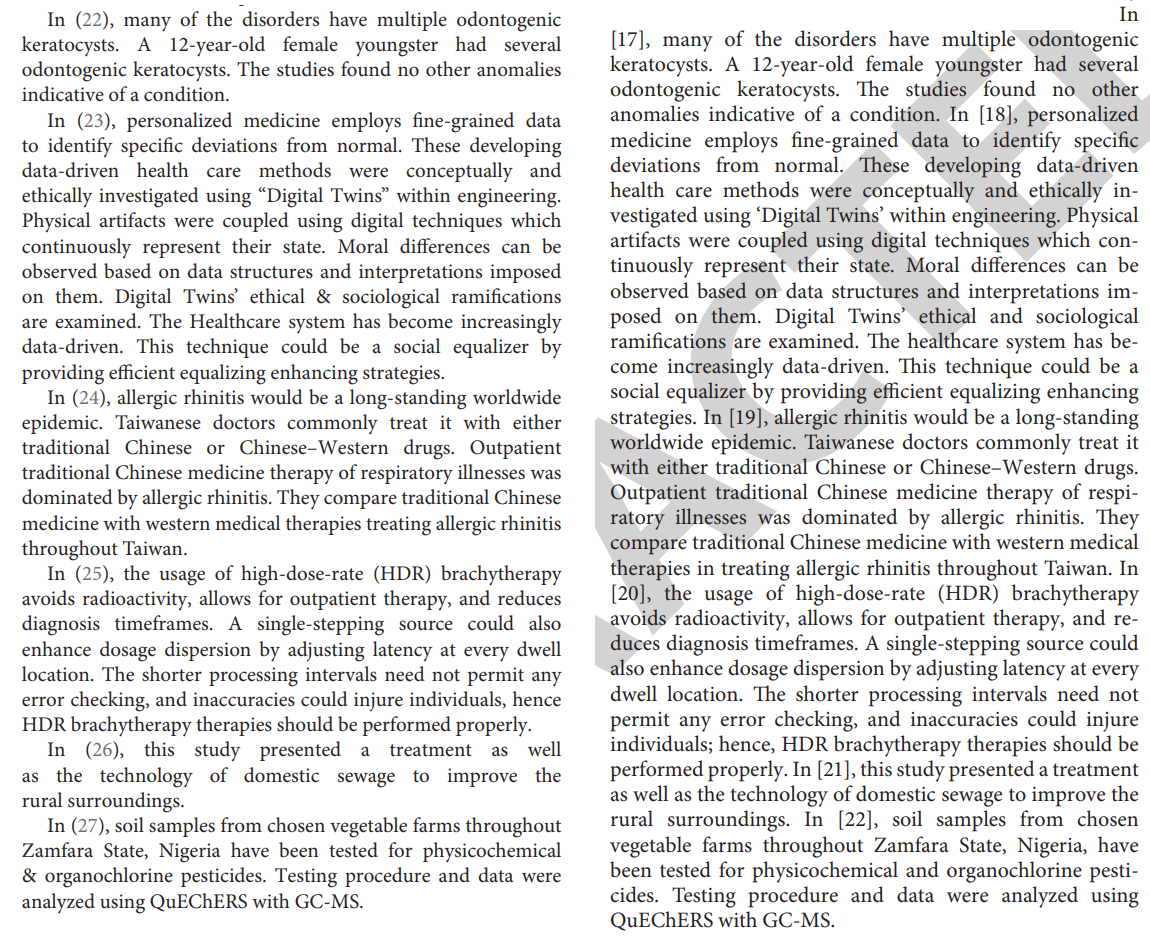
In fact, Frontiers peer review served merely as a tool to shoehorn in references to a predatory publisher:
“Most of these nonsensical citations involve “Science Progress & Research”, and I can only suppose that the predatory publisher of that journal paid to have its profile boosted. In this specific case, the brachytherapy paper by Shahabaz & Azfal (which should be Ref [25]) has been somehow displaced to [31] in the References, creating a systematic mismatch between Refs [25-31] and the corresponding descriptions in the text, which none of the reviewers or editors cared about“
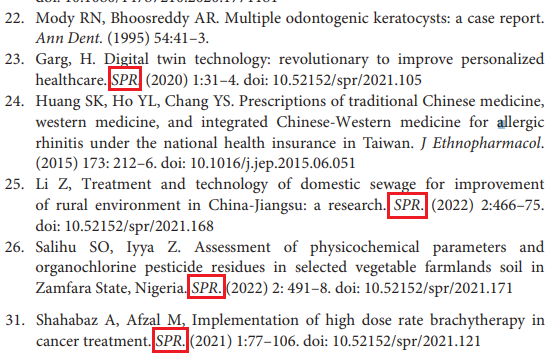
That’s what the famed Rigorous Peer Review(TM) at Frontiers really does.
Frontiers: a danger for public health?
Frontiers is a somewhat unconventional open access publisher, which likes to have it both ways: playing scientific elite while accepting almost anything from paying customers. My regular contributor Smut Clyde will tell you below how some anti-vaccine scare-mongers managed to sneak in some rather dangerous works thanks to Frontiers’ unofficial “we don’t judge, we just…
Perception of threat
More Frontiers in Public Health. Two German researchers in rank of group leaders helped an Iranian guest editor with self-references. And themselves to a paper outside of their own professed expertise. The corresponding author Katharina Löhr studies “Sustainable Land Use in Developing Countries” and is deputy group leader at the Leibniz Centre for Agricultural Landscape Research (ZALF). Her superior is the penultimate author, associate professor Stefan Sieber. This is their paper:
Maryam Tajeri Moghadam , Tahereh Zobeidi , Stefan Sieber , Katharina Löhr Investigating the Adoption of Precautionary Behaviors Among Young Rural Adults in South Iran During COVID-19 Frontiers in Public Health (2022) doi: 10.3389/fpubh.2022.787929
Quote, with references:
“Perception of threat includes two sub-components or social psychological beliefs: perceived susceptibility (PSU) and perceived severity (PSE). […] PSE means the belief that a severe health problem can lead to death or other serious consequences (40–42).”
[40] Yazdanpanah M, Forouzani M, Hojjati M. Willingness of Iranian young adults to eat organic foods: application of the Health Belief Model. Food Qual Prefer. (2015) 41:75–83. doi: 10.1016/j.foodqual.2014.11.012
[41] Bakhtiyari Z, Yazdanpanah M, Forouzani M, Kazemi N. Intention of agricultural professionals toward biofuels in Iran: Implications for energy security, society, and policy. Renew Sustain Energy Rev. (2017) 69:341–9. doi: 10.1016/j.rser.2016.11.165
[42] Tajeri moghadam M, Raheli H, Zarifian S, Yazdanpanah M. The power of the health belief model (HBM) to predict water demand management: A case study of farmers’ water conservation in Iran. J Environ Manage. (2020) 263:110388. doi: 10.1016/j.jenvman.2020.110388
What exactly does fear of virus infection have to do with organic foods, biofuels, and water management? There is also a reference 52 about rice agriculture which the authors included, but forgot to cite in their COVID-19 study:
[52] Boazar M, Abdeshahi A, Yazdanpanah M. Changing rice cropping patterns among farmers as a preventive policy to protect water resources. J Environ Plann Manage. (2020) 1–17. doi: 10.1080/09640568.2020.1729705
There is really no mystery why the Iranian researcher Masoud Yazdanpanah had to be cited. He is the special issue’s editor and the handling editor of this very paper, and the first author Maryam Moghadam, currently in the Netherlands, is his PhD student.
But why are Sieber and Löhr in on this? They never replied to my emails. Yes, they know things about agriculture in developing world, and the people allegedly studied in this paper live in the Iranian countryside. Which is where Löhr’s and Sieber’s relevant academic expertise ends. How dependent did German academics become on papers from Iran, they are ready to swallow anything, even nonsense gift citations, just to be listed as coauthors. Corresponding authors especially!
German Authorities on Papermills and Whistleblowing
“I am not familiar with Iranian papermills!” – Prof Dr med Henning Madry, Saarland University.
Anyway. In the same Frontiers special issue, this study from russia was published on 22 April 2022:
Ivan Stepanov , Nadejda Komendantova Analyzing Russian Media Policy on Promoting Vaccination and Other COVID-19 Risk Mitigation Measures Frontiers in Public Health (2022) doi: 10.3389/fpubh.2022.839386
“The Russian information system, in general and in the case of the COVID-19 pandemic, is characterized by the role of the state, which aims to achieve certain economic, political, and social goals and objectives. Such a system makes it possible to achieve planned indicators, which makes the overall information strategy appropriate, especially during catastrophes and crises. Our results show that such a strategy creates a calming and reassuring atmosphere with a proposed solution in the form of the promotion of accepted political decisions…”
Sputnik V: fraudulent халтура
Sputnik V clinical trial data seems as trustworthy as Putin’s election results.
Never mind the faulty, dangerous or inefficient yet mandatory russian vaccines and government-promoted fake COVID-19 cures, never mind the TV scaremongering and the official ban on western vaccines, never mind those draconic pandemic restriction laws which only ever applied to dissidents (even on one-man picket!), who were stuffed into overcrowded jails and got infected with COVID-19 there. Two months before this paper was published, mass murder in Ukraine began with an “accepted political decision” on 24 February 2022, which reveals the real meaning of this russian paper celebrating totalitarian indoctrination. According to Frontiers peer review, russian state propaganda of genocide provides “a calming and reassuring atmosphere with a proposed solution“. The Final Solution for the Ukrainian question.
Boycott Russian Science (and Everything Else) – Thoughts on War in Ukraine
The state it’s in, we don’t need Russian science anyway.
The pivotal roles of miRNAs
Guillaume Cabanac started to screen papers for references to retracted studies.
This medical review, from the University of Sao Paulo in Brazil, really raises the question if it should be withdrawn for disinformation.
G. M. Viera , K. B. Salomao , G. R. De Sousa , M. Baroni , L. E. A. Delsin , J. A. Pezuk , M. S. Brassesco miRNA signatures in childhood sarcomas and their clinical implications Clinical & Translational Oncology (2019) doi: 10.1007/s12094-019-02104-z
“…this review focuses on what has been learned about the pivotal roles of miRNAs in the regulation of key genes implicated in childhood sarcomas.”
Cabanac wrote on PubPeer:
“Readers should reassess the reliability of this Springer review article as its bibliography includes several questioned references that are likely to be unreliable:
- 51 retracted or withdrawn references
- 6 questioned references”
The scientific sea of miR- and exosome-related knowledge
“Whole cohorts of peer-reviewers have been trained to view all these mannerist stylings as what western blots should look like. […] It will be a challenge to convince them otherwise.” – Smut Clyde.
Cabanac writes that he used Problematic Paper Screener and Feet of Clay Detector. To be fair, the review has 637 references, but those retracted and questionable references go to products of Chinese papermills. Here is a representative one, not retracted yet, and I am showing you just some examples of what Smut Clyde found there:
Xinzhen Guo , Jie Zhang , Jianfeng Pang , Sheng He , Guojun Li , Yang Chong , Chao Li , Zhijian Jiao , Shiqian Zhang , Ming Shao MicroRNA-503 represses epithelial-mesenchymal transition and inhibits metastasis of osteosarcoma by targeting c-myb Tumor Biology (2016) doi: 10.1007/s13277-016-4797-4

[right] Fig 5C from “MiR-506 suppresses tumor proliferation and invasion by targeting FOXQ1 in nasopharyngeal carcinoma” (Zhang et al 2015) [retracted].”

Fig 3C.
Fig 3B from “Up-Regulation of MiR-300 Promotes Proliferation and Invasion of Osteosarcoma by Targeting BRD7” (Xue et al 2015) [retracted].
Fig 5C from “miR-203 Acts as a Tumor Suppressor Gene in Osteosarcoma by Regulating RAB22A” (Yang et al 2915).”

[right] Fig 5A from “MiR-144 Inhibits Uveal Melanoma Cell Proliferation and Invasion by Regulating c-Met Expression” (Sun et al 2015) [retracted].”
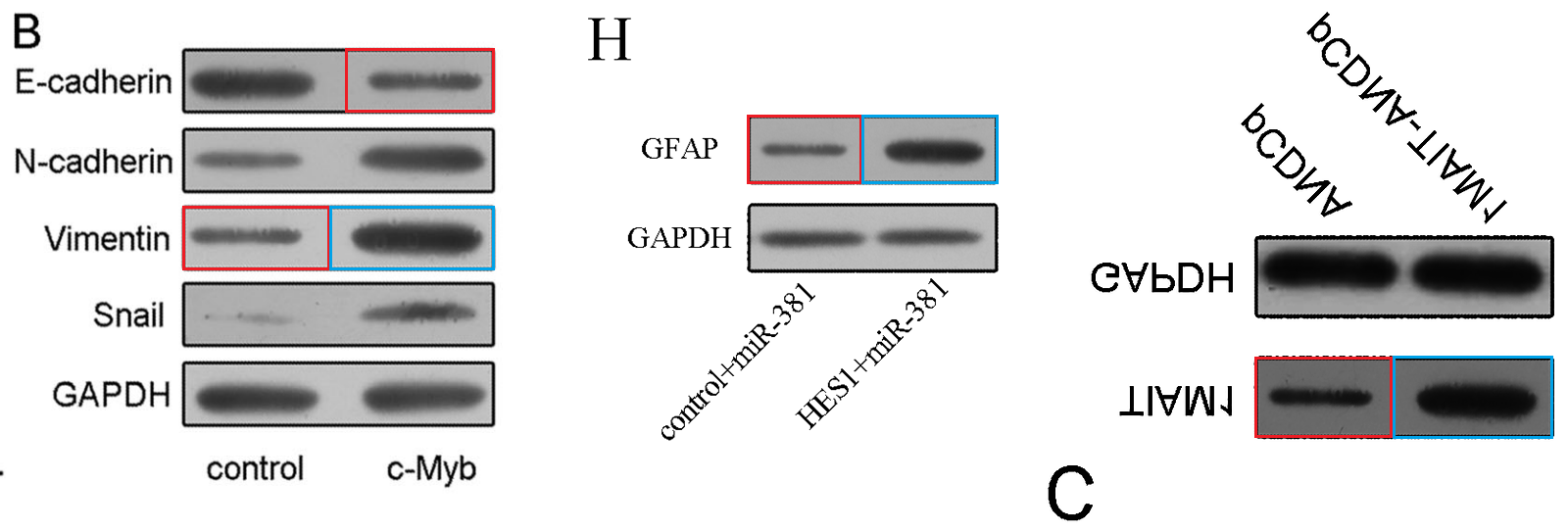
Fig 4B.
Fig 6H from “miR-381 Regulates Neural Stem Cell Proliferation and Differentiation via Regulating Hes1 Expression” (Shi et al 2015).
Fig 5C from “The Downregulation of MiR-182 Is Associated with the Growth and Invasion of Osteosarcoma Cells through the Regulation of TIAM1 Expression” (Hu et al 2015). Flipped vertically for convenience.”
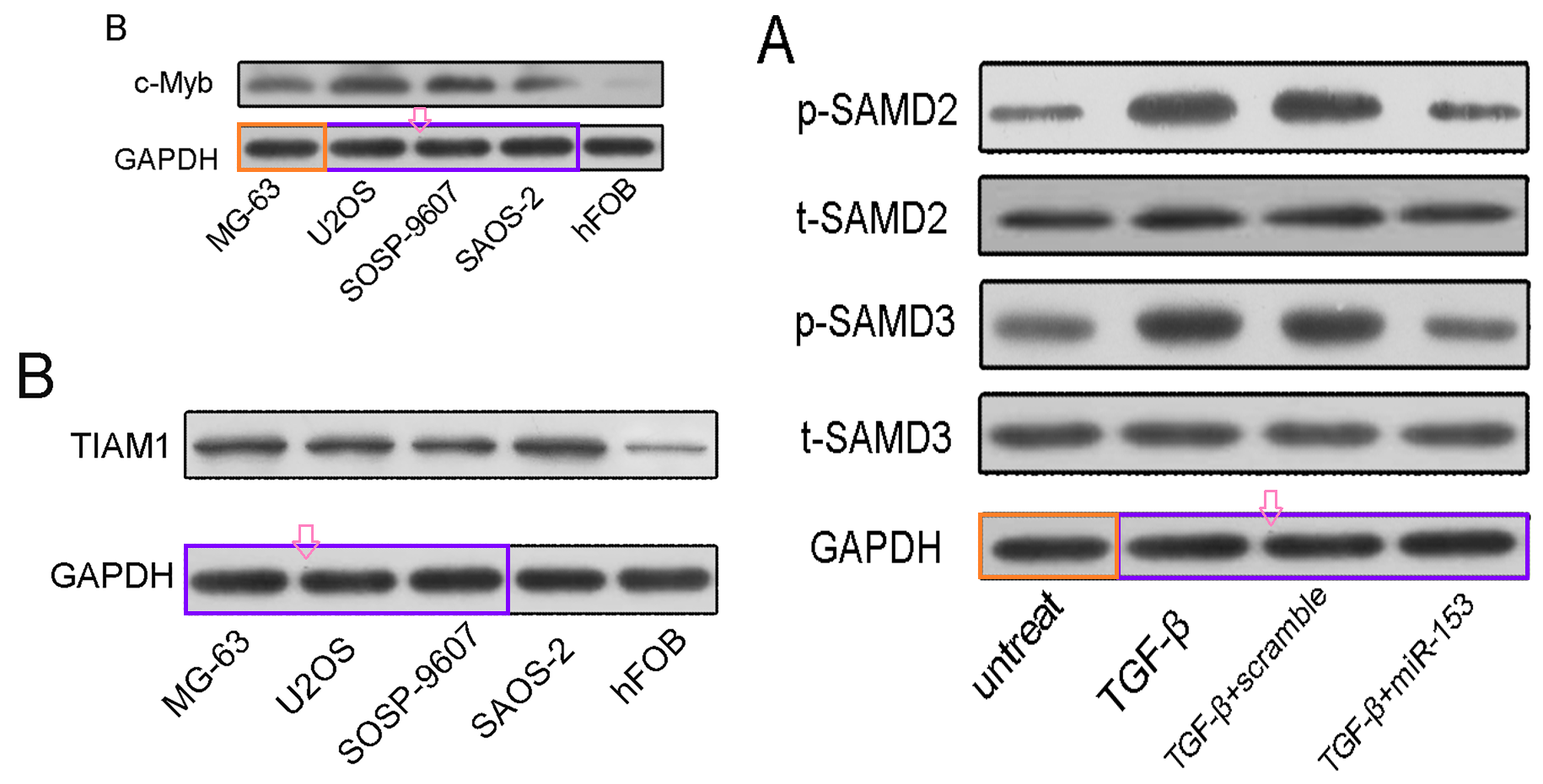
[lower left] Fig 5B from “The Downregulation of MiR-182 Is Associated with the Growth and Invasion of Osteosarcoma Cells through the Regulation of TIAM1 Expression” (Hu et al 2015).
[right] Fig 4A from “MicroRNA-153 Inhibits Osteosarcoma Cells Proliferation and Invasion by Targeting TGF-β2” (Niu et al 2015) [retracted].”
Other references, go to questionable sources as well, even if from “white” people. Like the toxic cheaters like Carlo Croce and George Calin, the inventors of miRNA-oncology scam:
Croce begat Calin, and Calin begat Girnita…
An academic dynasty of bad cancer research.
What exactly is the point of such reviews, where random trash papers are added en masse without anyone ever even reading them past the title? Is this supposed to improve the quality of paediatric health care, somehow?
Sneaked references
And here is Cabanac again, with a new preprint:
Lonni Besançon, Guillaume Cabanac, Cyril Labbé, Alexander Magazinov Sneaked references: Cooked reference metadata inflate citation counts arXiv (2023) doi: 10.48550/arXiv.2310.02192
From the abstract:
“We report evidence of an undocumented method to manipulate citation counts involving ‘sneaked’ references. Sneaked references are registered as metadata for scientific articles in which they do not appear. This manipulation exploits trusted relationships between various actors: publishers, the Crossref metadata registration agency, digital libraries, and bibliometric platforms. By collecting metadata from various sources, we show that extra undue references are actually sneaked in at Digital Object Identifier (DOI) registration time, resulting in artificially inflated citation counts.”
Alexander Magazinov gave me an explainer of what he and his colleagues found out:
“(1) An Indian author submits a garbage paper to a predatory journal.
(2) The predatory publisher accepts and places the pdf as supplied by authors, with garbage, but reasonable refs.
(3) The publisher submits the entry to Crossref, where in addition to / instead of the actual refs there go refs to two specific [scholars] and ref to journals of the same publisher.
(4) Whoever uses Crossref for indexing refs, Dimensions included, index the fake list of references, not the one in pdf.“
Here is one case the preprint discusses, a Hindawi paper:
D. Veeraiah , G. Joel Sunny Deol , Rajendra Kumar Ganiya , J. Nageswara Rao, Suneetha Bulla , Assefa Alene Energetic and Valuable Path Compendium Routing Using Frustration Free Communication Dimension Extension Algorithm in MANET Wireless Communications and Mobile Computing (2022) doi: 10.1155/2022/3685419

references in the allegedly citing publications. After careful examination, it appeared that these were sneaked
references: existing in the metadata only and not in the PDFs of the allegedly ‘citing’ publications.“
The Hindawi paper was retracted on 28 June 2023 due to “systematic manipulation of the publication process“.
Crossref is not actively involved in this scam, but they do take money from predatory publishers and even papermills in return of doi indexing. The result is what you read above.
Ukrainian papermills – symptom, not a cause
“Prof. Dr. Svetlana Drobyazko, The European Academy of Sciences Ltd and Scientific Publication Service are a symptom, not a cause, of the current problems in academic publishing. ” – Nick Wise
Retraction Watchdogging
To minimize the stress levels
In previous Friday Shorts, I wrote about the mysterious disappearance of an institute director and his institute. It seemed, the Albany College of Pharmacy and Health Sciences (ACPHS) in New York, USA, sacked their Vice-Provost of Research Shaker Mousa. All online records of himself and his Pharmaceutical Research Institute (PRI) have been wiped off internet.
Shaker Mousa – NY pharma gangsta’
Yo, what’s up, my homies, Shaker Mousa is in da house.
Two new retractions, to accompany Mousa’s six previously retracted papers, provide insights at what went on.
Weikun Li , Murat Yalcin , Dhruba J. Bharali , Qishan Lin , Kavitha Godugu , Kazutoshi Fujioka , Kelly A. Keating , Shaker A. Mousa Pharmacokinetics, Biodistribution, and Anti-Angiogenesis Efficacy of Diamino Propane Tetraiodothyroacetic Acid-conjugated Biodegradable Polymeric Nanoparticle Scientific Reports (2019) doi: 10.1038/s41598-019-44979-6


Nanotechnology (2009), DOI:10.1088/0957-4484/20/45/455104.”
Mouse claimed in August 2022 on PubPeer that it were the images in the old paper that were “incorrectly placed“.
A Retraction arrived on 3 October 2023 (highlights mine):
“An investigation by Albany College of Pharmacy and Health Sciences has concluded that the content of four images in Fig. 10b appears to have been misrepresented.
Specifically:
- The PBS control appears identical to b-FGF + 7 in Fig. 41 and to PBS image in Fig. 4 of2.
- The b-FGF image appears identical to VEGF in ‘corrected’ Fig. 2A of3.
- The b-FGF + DAT image appears identical to b-FGF + 5 in Fig. 4 of1 and to b-FGF + Au-glucose in Fig. 4 of2.
- The b-FGF + N-DAT image appears identical to b-FGF + tetrac in Fig. 4 of1 and to b-FGF + Ag-DAPHP in Fig. 4 of2.
The Editors therefore no longer have confidence in the results and conclusions presented.
Murat Yalcin, Qishan Lin, Kavitha Godugu, Kazutoshi Fujioka, Kelly A. Keating & Shaker A. Mousa did not respond to the correspondence from the Editors about this retraction. The Editors were not able to confirm the current contact details for Weikun Li and Dhruba J. Bharali.”
And this second retracted paper was not even flagged on PubPeer before:
Abdelhadi Rebbaa , Fei Chu , Thangirala Sudha , Christine Gallati , Usawadee Dier , Evgeny Dyskin , Murat Yalcin , Christine Bianchini , Olfat Shaker , Shaker A Mousa The anti-angiogenic activity of NSITC, a specific cathepsin L inhibitor Anticancer Research (2009) 29(11): 4473-4481
The retraction notice dated October 2023 was very brief, but telling:
“The paper entitled “The Anti-angiogenic Activity of NSITC, a Specific Cathepsin L Inhibitor” by Rebbaa A et al., published in Anticancer Research 29(11): 4473-4481, 2009, is retracted due to image manipulation as proven following an investigation by the Albany College of Pharmacy and Health Sciences.”
It suggests that all papers by Mousa were investigated by ACPHS, even those not flagged on PubPeer. He was then most likely found guilty of research misconduct, sacked, and ACPHS ordered the retractions of his papers.

Worried about Mousa’s situation, Cheshire wrote to MDPI, where our Egypt-born pharma cheater is still Editor-in-Chief of the journal Biomedicines. He received this reply from a Journal Relations Specialist, MDPI Open Access Publishing Romania SRL:
“Dear Reader,
Thank you for your email.
In 2020, our Editor in Chief, Prof. Dr. Shaker Mousa, has had some serious health issues. Due to these issues, he has decided to close the Pharmaceutical Research Institute (PRI) in 2022 to minimize the stress levels. He has continued his remaining work on a part time basis until he finished his last course in 2022 and then fully retired in early 2023. The new affiliation of our Editor in Chief has been displayed on
our website as well. Our journal does not intend, by any means, to showcase discrepancies. We hope that this answers your query.We wish you all the best.“
How can someone type this silliness with a straight face…
Original uncropped version from imager
Congratulations to the laureate of the 2019 Nobel Prize in Physiology or Medicine Gregg Semenza to his 10th retraction. I suspect the Johns Hopkins University would love to get rid of Semenza now, but it really makes a bad show to sack a Nobelist, and second, he may still be bringing lots of NIH and industry money, exactly because this cheater won the Nobel.
Gregg Semenza: real Nobel Prize and unreal research data
“Even after people have been telling you for, you know, 20 years or more that it’s going to happen, no one expects it.” -Gregg Semenza, Nobel Prize winner 2019
This 10th retracted paper again features the Johns Hopkins Vice-Provost for Research, Denis Wirtz, and Semenza failed scientist mentee, Johns Hopkins assistant professor Daniele Gilkes:
Daniele M. Gilkes , Saumendra Bajpai , Carmen C. Wong , Pallavi Chaturvedi , Maimon E. Hubbi , Denis Wirtz, Gregg L. Semenza Procollagen lysyl hydroxylase 2 is essential for hypoxia-induced breast cancer metastasis Molecular Cancer Research (2013) doi: 10.1158/1541-7786.mcr-12-0629
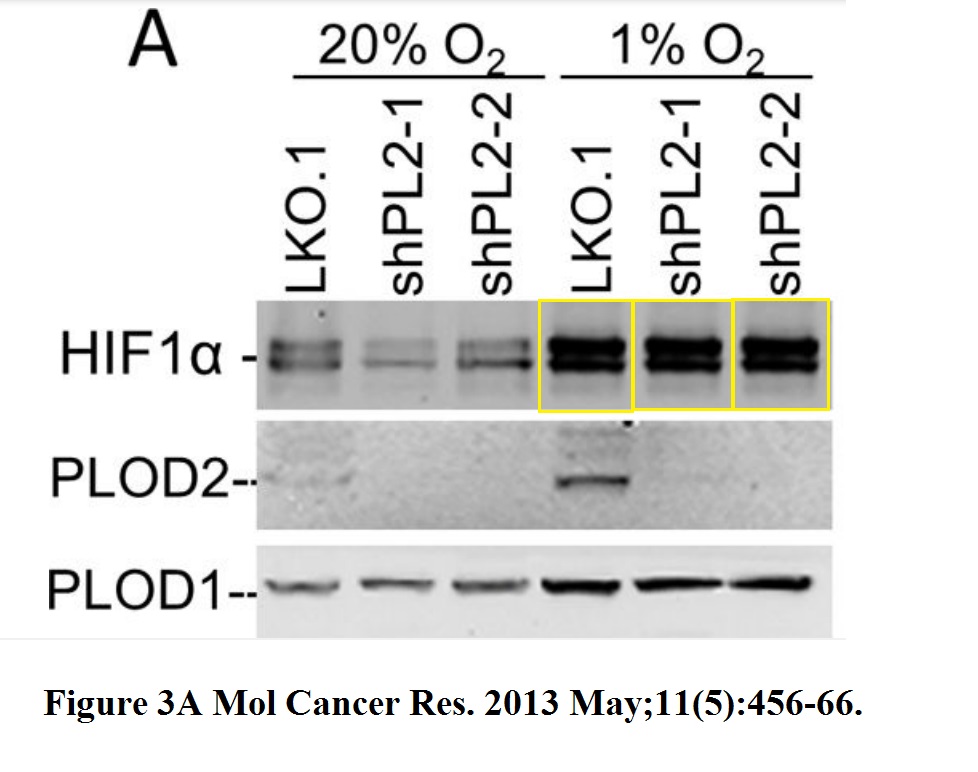
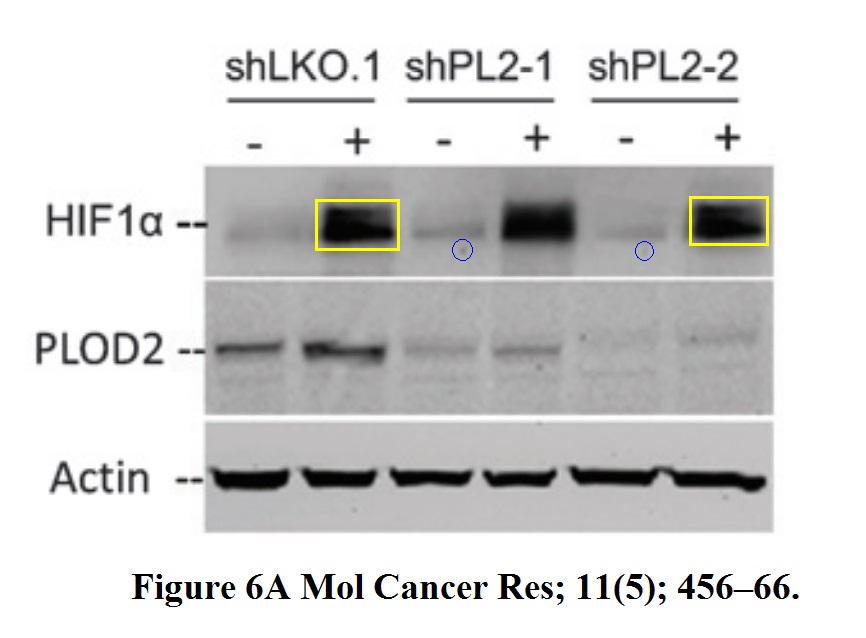
In October 2020, Gilkes posted this “original uncropped version from imager” which proved to be fake, here in false colour and with duplicated gel bands labelled.
The Retraction notice, published on 2 October 2023, is particularly stupid and pathetic:
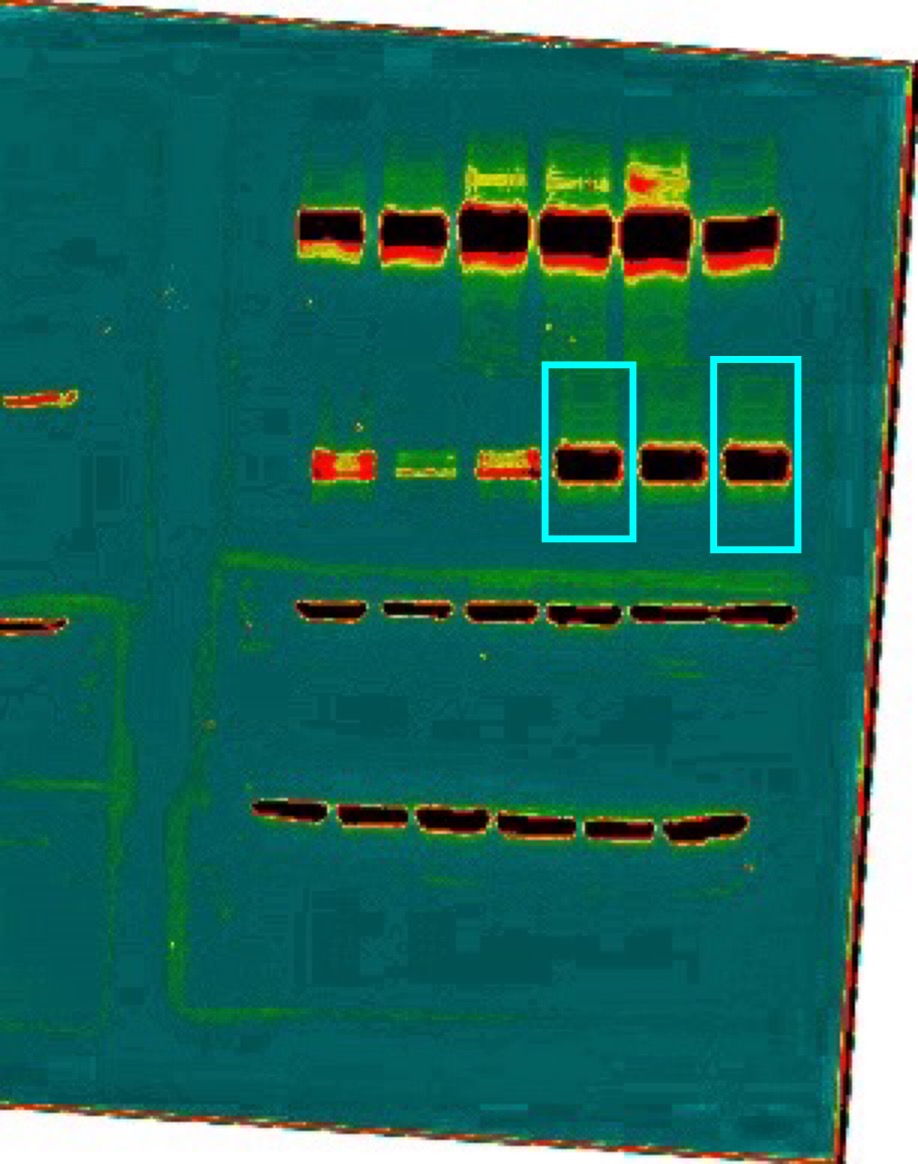
“This article (1) has been retracted at the request of the authors. The authors found that lanes 4, 5, and 6 of the HIF-1α immunoblot in Fig. 3A are identical images. An internal review corroborated the authors’ claim, and the editors agreed with the authors’ retraction request. The authors apologize to the scientific community and deeply regret any inconveniences or challenges resulting from the publication and subsequent retraction of this article.”
At least they didn’t blame a nameless student who wasn’t an author and who left the lab years ago. What the authors still haven’t found out is that they are as fake as their figures, and yes, I do think it is worth investigating who really did the work for which Semenza scooped his Nobel.
And who is the nincompoop Editor-in-Chief who approved this retraction notice? Same one who retracted Mousa’s paper above, referencing an institutional investigation: Massimo Loda from Weill Cornell. Who unlike Semenza doesn’t have a Nobel, and therefore escaped the limelight and doesn’t have to retract his own fake science:
AACR deploys Massimo Loda on a mission to cure cancer
Meet Massimo Loda, the new EiC of Molecular Cancer Research. Not despite, but because of his PubPeer record. Also meet his partner Michele Pagano!
Despite internal data validation
Another US researcher retracts another paper. This time, it’s Gary Dunbar, former professor of psychology at Central Michigan University, now with “faith-based healthcare organization” Ascension St. Mary’s. You may have met Dunbar in earlier Friday Shorts where he dragged out his lab members one by one to apologise for fake data.
Panchanan Maiti, Zackary Bowers, Ali Bourcier-Schultz, Jarod Morse , Gary L. Dunbar Preservation of dendritic spine morphology and postsynaptic signaling markers after treatment with solid lipid curcumin particles in the 5xFAD mouse model of Alzheimer’s amyloidosis Alzheimer’s Research & Therapy (2021) doi: 10.1186/s13195-021-00769-9
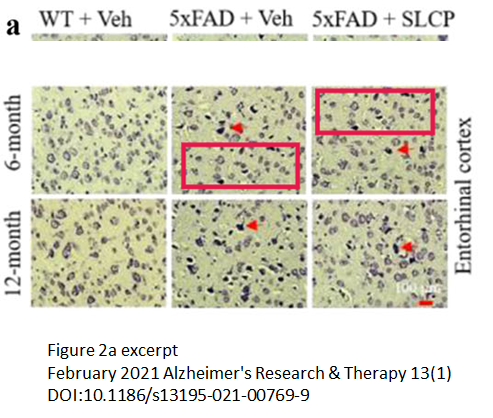


In October 2021, Dunbar wrote on PubPeer:
“We have initiated an investigation into what happened here and this will include a re-examination of all the data in this study.”
A Correction was published in March 2022:
“Following the publication of the original article [1] the authors noticed errors in the published Figs. 2, 4 and 5. The original article [1] has been updated.”
Sadly, not everything was corrected by Springer Nature and their vigilant BioMedCentral editorial team:

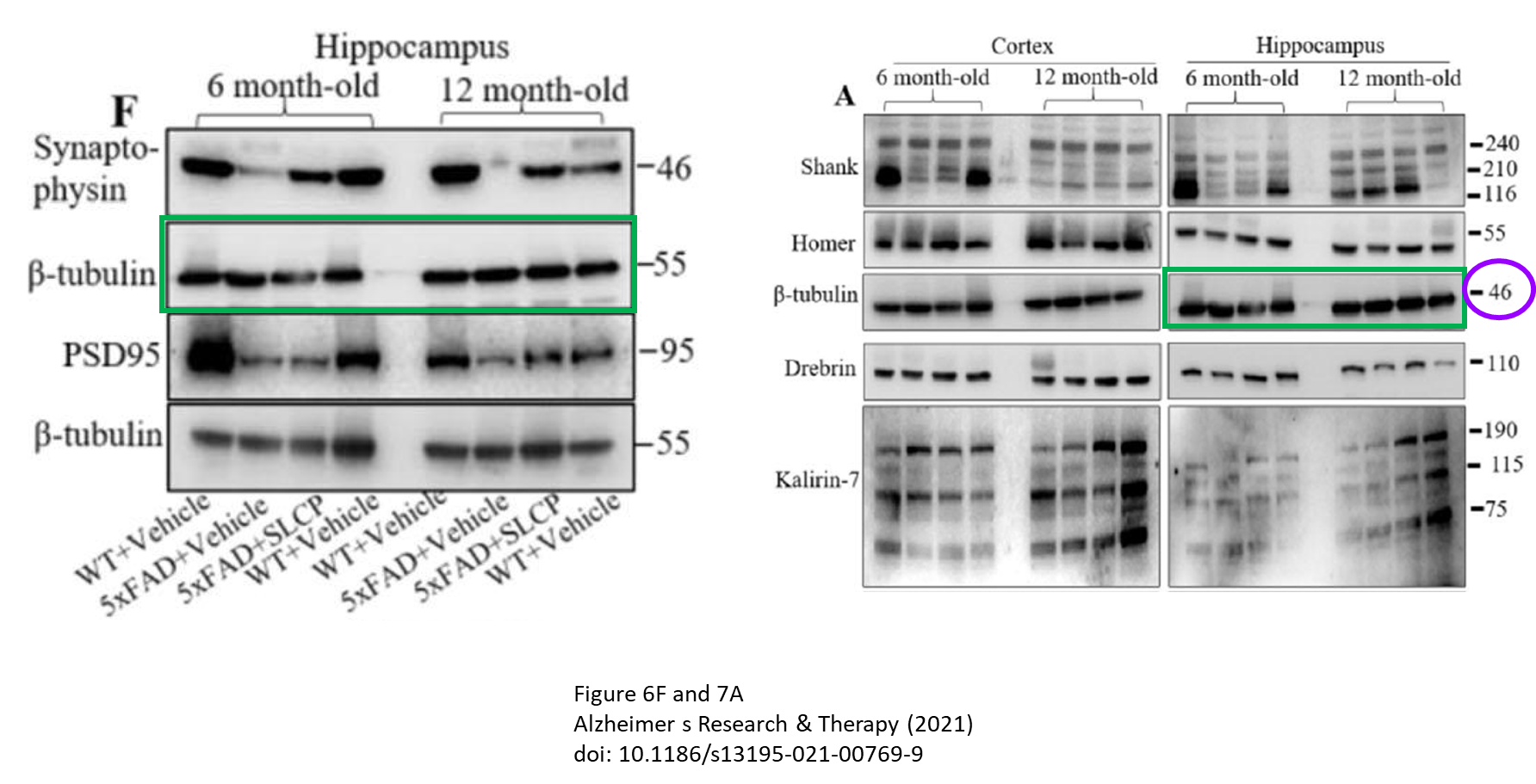
And one image was recycled from yet another fraudulent Dunbar paper, Maiti et al 2018, which was also published at BioMedCentral, and which was retracted in February 2023 “at the corresponding author’s request“:
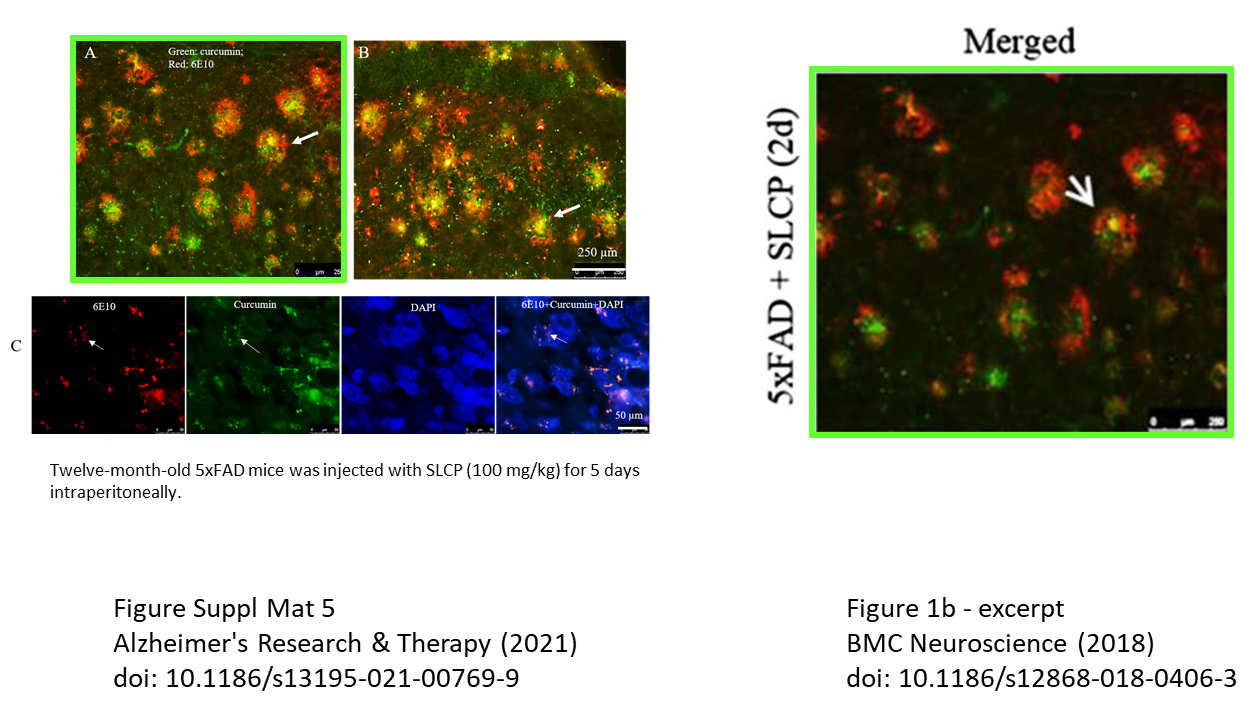
Even more unfortunate for the highly professional publication ethics and image integrity experts employed by Springer Nature and BioMedCentral, Dunbar’s corrected figure was fraudulent also:

Actinopolyspora biskrensis: “In the newly corrected Figure 4G and 4I, there appears to be another set of images which overlap (red boxes), with differential cropping and scaling. These transformations are difficult to understand as an error during figure assembly.”
In July 2022, Dunbar announced that everything was fine:
“As suggested, we conducted a thorough re-analyses, including doing re-counts of the dendritic spines and re-analyses of the data. We have sent these corrections to the journal, which included the information that data from 2 FxFAD and 2 wild-type control mice who underwent identical treatments in a previous study (doi: 10.3390/ijms21186664) were used in the analyses of the present study. We sincerely apologize for these mistakes and can assure you that we have taken rigorous measures to prevent such mistakes in the future.”
More than a year later, instead of a second correction, a retraction notice was published on 29 September 2023:
“The Editors-in-Chief have retracted this article at the authors’ request. After publication, concerns were raised regarding a number of cases of image overlap within the Figures, which the authors addressed by a Correction [1]. However, subsequent concerns have been raised about further image similarities within the article, as well as with previous studies. Specifically:
- Fig. 3b 5xFAD + Veh CAI 12-month-old group image appears highly similar to an image representing the same group in [2].
- In Fig. 3B, 5xFAD + SCLP Cortex and Entorhinal cortex images appear to originate from the same sample.
- In Fig. 3E, the beta-tubulin blots presented for the cortex 6- and 12-month-old groups appear highly similar; the beta-tubulin blot image for hippocampus in the 6-month-old group appears highly similar to that representing beta-tubulin in the 12-month-old group in Figs. 5F and 7A.
- The updated Fig. 4G 5xFAD Primary 6-month-old group image appears to overlap with Fig. 4I 5xFAD Secondary 12-month-old group.
- The top beta-tubulin blot in Fig. 6F appears highly similar to the beta-tubulin (hippocampus) blot in Fig. 7A.
- The blots in Fig. S2I appear highly similar to those in Fig. 3D of [3, now retracted].
- Fig. S5A appears highly similar to the Merged 5xFAR + SLCP (2d) image in Fig. 1B of [3, now retracted].
Despite internal data validation, the authors no longer have sufficient confidence in the findings of this study.”
I like this last statement. Classy.
“Dr. Gary Dunbar is a rock star…literally. When he was in his twenties, he put out an album; a collection of his personal tunes. Well, that was several years ago. While he still jams on his guitar, his status as a rock star is better suited for his research…” (EmbraceAging.com)
Editor-in-Chief no longer has confidence
The Springer journal Naunyn-Schmiedeberg’s Archives of Pharmacology, led by Roland Seifert and other German editors, previously became prey to Chinese papermills. After mass-retractions, the editors issued a public guideline, virtually banned Chinese submissions, and assumed the problem was solved. It wasn’t. Read here what happened next:
An attractive and “natural” target for fraudsters
“In the various excellent texts on paper mills the question is discussed why Naunyn-Schmiedebergs Archives of Pharmacology has become a target for fake papers. I oppose the assumption that we simply want to fill pages with pseudo-scientific content. We actually look for quality and good science.” – Prof Dr Roland Seifert, Editor-in-Chief
The editors now started to retract Egyptian papermill fraud which their journal accepted after the Chinese papermill clean-up. Here, by the El-Sherbiny brothers, originally reported by Mu Yang:
Sharifa Alzahrani , Sadeem M. Ajwah , Sumayyah Yasser Alsharif , Eman Said , Mohamed El-Sherbiny , Sawsan A. Zaitone , Mohamed Al-Shabrawey , Nehal M. Elsherbiny Isoliquiritigenin downregulates miR-195 and attenuates oxidative stress and inflammation in STZ-induced retinal injury Naunyn-Schmiedeberg’s Archives of Pharmacology (2020) doi: 10.1007/s00210-020-01948-5

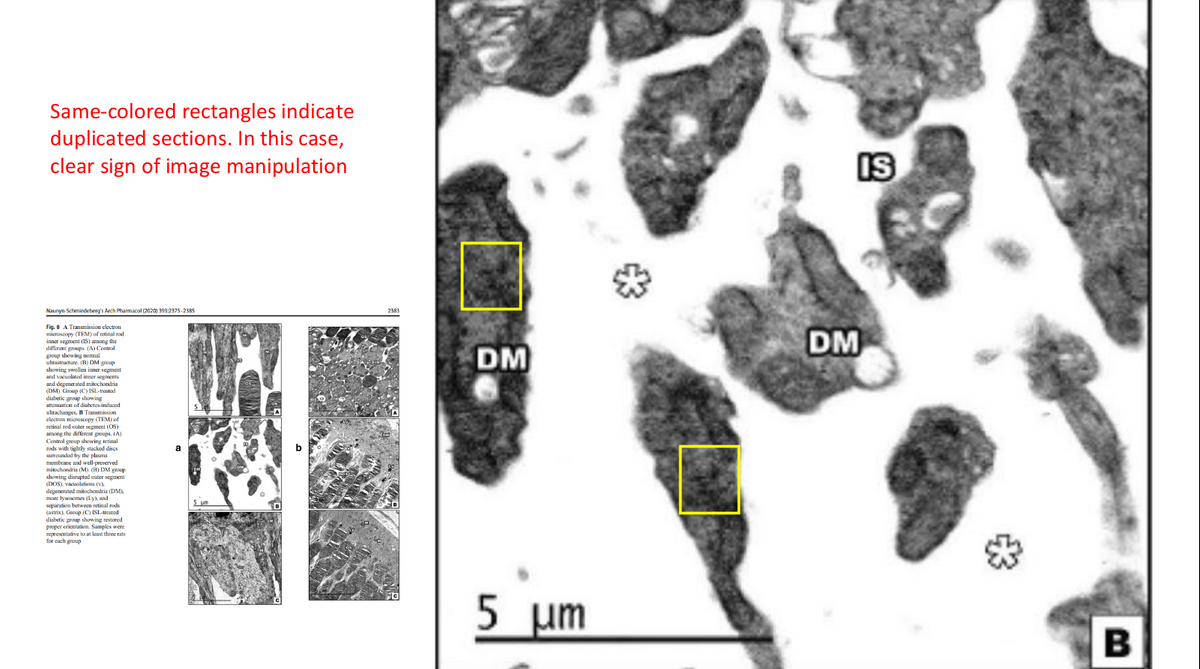

The retraction was published on 28 September 2023:
“The Editor-in-Chief has retracted this article. After publication, concerns were raised regarding partial image duplication between Fig. 2b Control and Diabetes + ISL groups, as well as within the images presented in Fig. 8. The authors have provided raw data to address these issues. However, there appear to be discrepancies between the raw data and the published images. The Editor-in-Chief therefore no longer has confidence in the published data.
Mohamed El-Sherbiny and Nehal M. Elsherbiny have not explicitly stated whether they agree to this retraction. None of the other co-authors have responded to any correspondence from the publisher about this retraction.”
And here yet another El-Sherbiny brother:
Aya A El-Demerdash , Esther T Menze , Ahmed Esmat, Mariane G Tadros , Doaa A Elsherbiny Protective and therapeutic effects of the flavonoid “pinocembrin” in indomethacin-induced acute gastric ulcer in rats: impact of anti-oxidant, anti-inflammatory, and anti-apoptotic mechanisms Naunyn-Schmiedeberg’s Archives of Pharmacology (2021) doi: 10.1007/s00210-021-02067-5
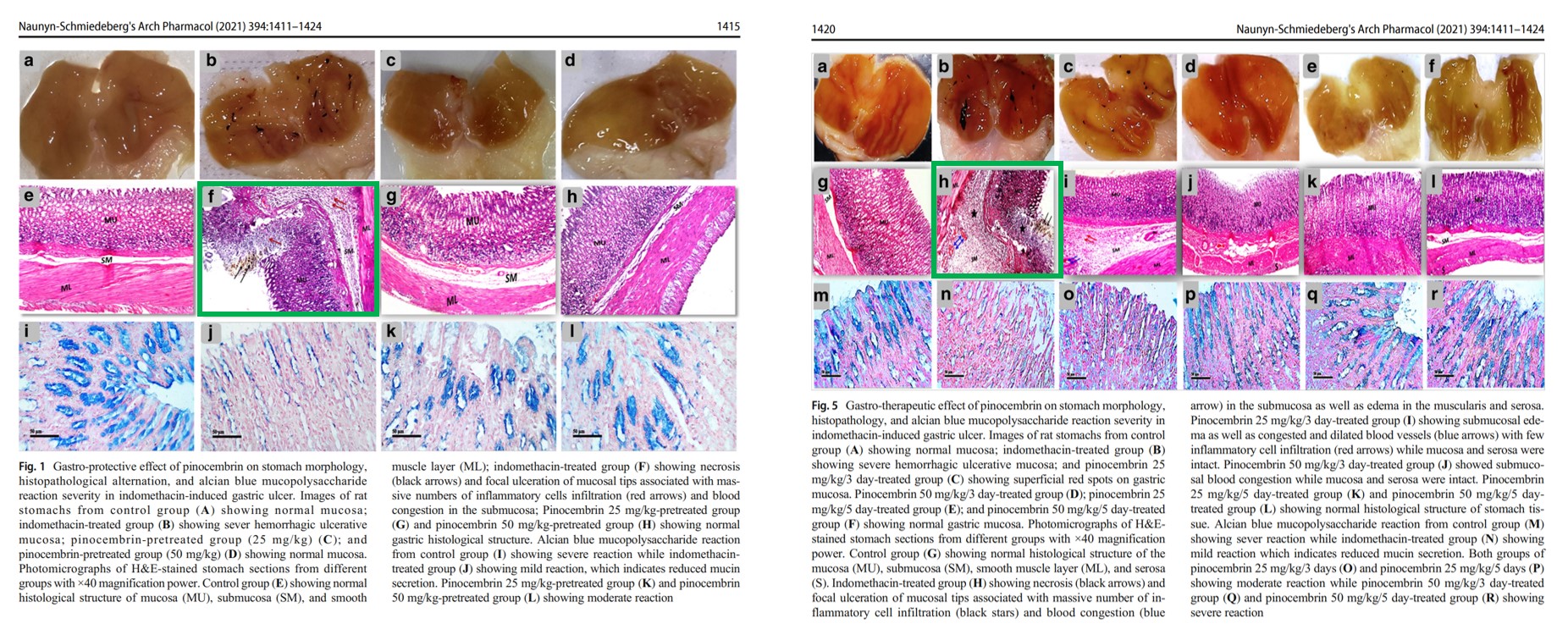
This one was also retracted on 28 September 2023:
“The Editor-in-Chief has retracted this article. After publication, concerns were raised regarding similar images in figures representing different experiments, specifically:
- Fig. 1f appears highly similar to 5h (rotated);
- Fig. 6a appears similar to 6e (mirror image, enlarged).
The authors have provided the raw data for validation and stated that the same control and INDO groups were used for both experiments in Figs. 1 and 5; however, this is inconsistent with the experimental protocol presented in Fig. 1. The authors have also confirmed that the image in Fig. 6e was inserted incorrectly and does not represent Caspase-3 staining.
The Editor-in-Chief therefore no longer has confidence in the presented data and the conclusions of this article.
None of the authors agree to this retraction.”
Expect more Egyptian papermill retractions in this journal.
My laptop was formatted
The Elsevier journal Toxicology Reports does retract fake papers after all.
Lashing out at Toxicology Reports
“What exactly will Lash and Elsevier do with these 115 problematic papers? I can only expect a painfully inadequate response.” – Sholto David
This was flagged on PubPeer by Sholto David under the pseudonym Mycosphaerella arachidis:
Shunbang Yu , Feng Wang , Yujie Bi , Pu Wang , Rui Zhang , Joanna Bohatko-Naismith, Xudong Zhang , He Wang Autophagy regulates the Wnt/GSK3β/β-catenin/cyclin D1 pathway in mesenchymal stem cells (MSCs) exposed to titanium dioxide nanoparticles (TiONPs) Toxicology Reports (2020) doi: 10.1016/j.toxrep.2020.08.020

“A number of bands have been reused between different figures to create composite blots.”
The lead author He “Harry” Wang, senior lecturer in occupational health at the University of Newcastle, Australia, wrote on PubPeer in May 2023:
“I am checking with the two first authors (one was a student and graduated recently). It is likely that the two co-first authors caused errors by mixing up the original data labeled similarly without communication with each other. To verify the results, I am asking lab to repeat the experiment and we will share the results (original data) in a few weeks.”
It turned out, the international gang of laptop thieves and laptop destroyers which keeps breaking in into homes and labs of research cheaters worldwide, reached Australia. Wang posted this, also in May 2023:
“I just received feedback from the student who conducted the experiment. Hi Dr. Wang, My laptop was formatted by the university’s IT department when I left, so it may not be so easy to find the original raw data anymore. I am not sure if a mistake was made during data processing and the scans were mixed up, it may take some time to retrieve my data or redo the experiment and provide a new figure with raw data. Best, Shunbang”
Wang then announced:
“Similar things happened in another paper published in a different journal. I cannot be tolerant and will recall the paper.”
Most likely, his university convinced Wang that the laptop defense was silly and that he will have to pull his paper. Eventually, Toxicology Reports‘ toxic Editor-in-Chief Lawrence Lash gave in to Wang’s requests, the original article has been removed completely and a retraction notice was posted instead a few days ago:
“This article has been retracted at the request of the corresponding author.
Following concerns raised in the public domain about the similarities between the Western Blots from Figures 4c and 5a, the corresponding author contacted the journal to request the retraction of the article as the raw data were reportedly not retrievable. The Editor-in-Chief approved the retraction given the unavailability of the raw data.
The authors apologize for any inconvenience this has caused.”
Third time unlucky
A fake paper from Swinburne University of Technology in Melbourne, Australia, has been retracted, but how!
Ali Nazari , Ali Bagheri , Jay G. Sanjayan, Melissa Dao , Chathumini Mallawa , Peita Zannis , Samuel Zumbo Thermal shock reactions of Ordinary Portland cement and geopolymer concrete: Microstructural and mechanical investigation Construction and Building Materials (2019) doi: 10.1016/j.conbuildmat.2018.11.098


The retraction notice was published on 30 September 2023:
“This article has been retracted at the request of the Editor in Chief, who no longer has confidence in its content.
This article was previously corrected via two corrigenda: https://doi.org/10.1016/j.conbuildmat.2021.123706 and https://doi.org/10.1016/j.conbuildmat.2021.124151. One of the co-authors submitted a third corrigendum correcting Table 1 and Figures 3 and 4. Furthermore, the co-author acknowledges that the original data for Figures 3 and 4 is not in their possession and cannot be provided to the journal for verification. The third corrigendum was delayed coming to be published and subsequently, the co-author has asked to further revise the third corrigendum.
For these reasons and based on additional concerns raised related to the second corrigendum (referenced above), the editors no longer have confidence in this paper.”
Elsevier tried everything to save this fake paper, but if the authors can’t get their lies straight, even at fourth attempt…
I thank all my donors for supporting my journalism. You can be one of them!
Make a one-time donation:
I thank all my donors for supporting my journalism. You can be one of them!
Make a monthly donation:
Choose an amount
Or enter a custom amount
Your contribution is appreciated.
Your contribution is appreciated.
DonateDonate monthly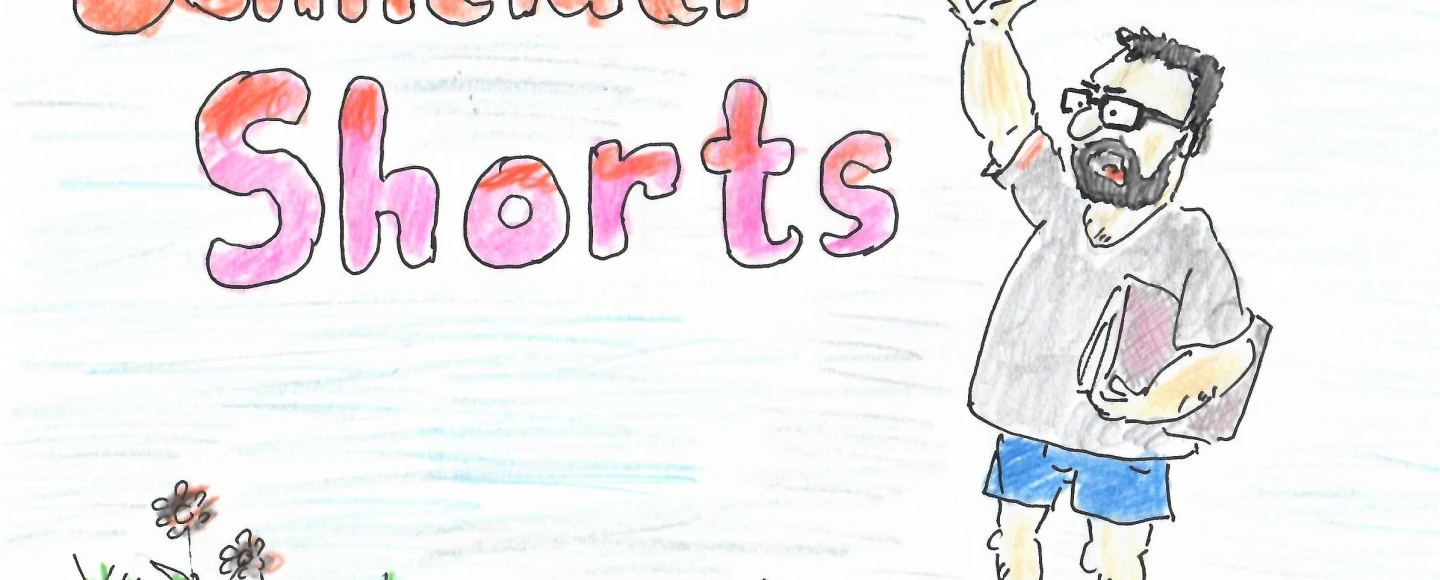
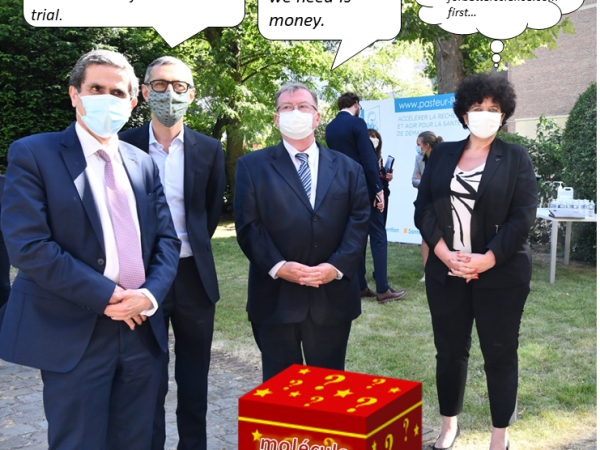
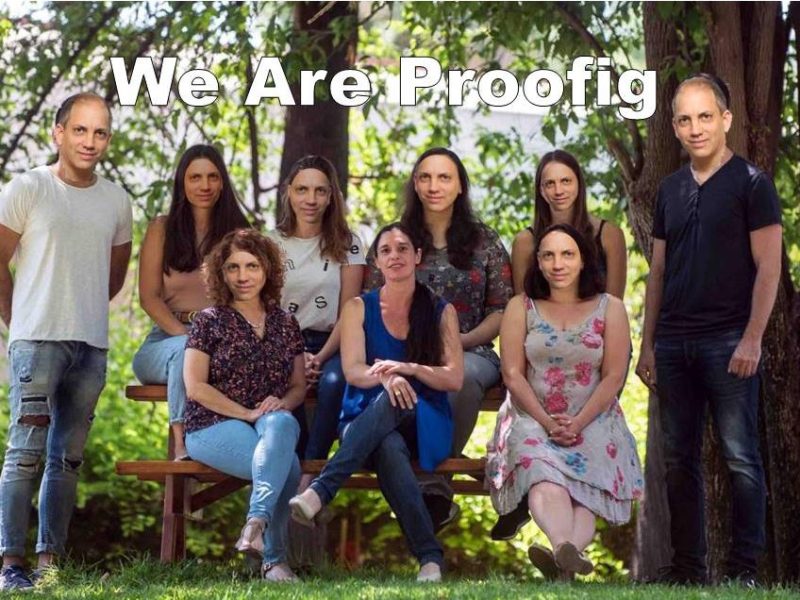
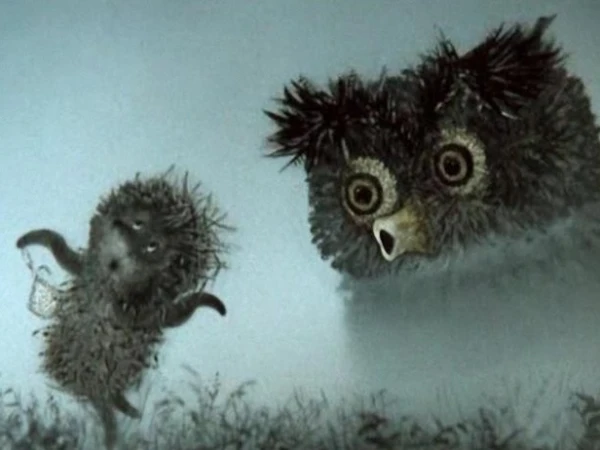






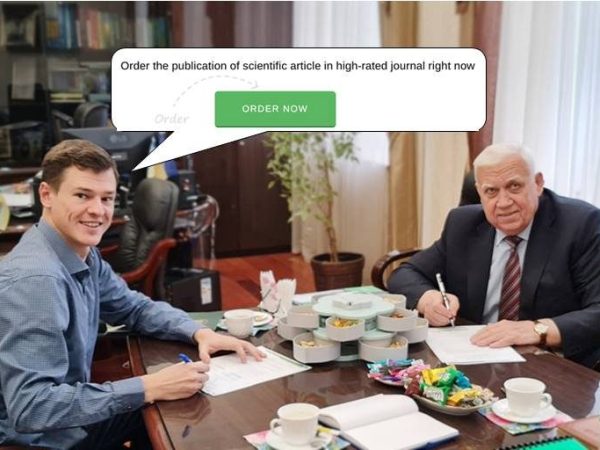

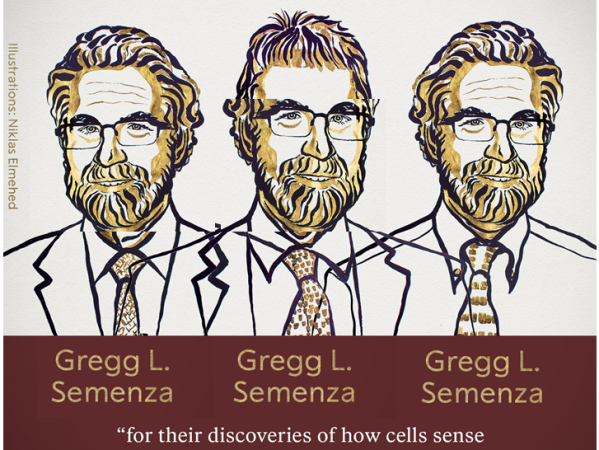
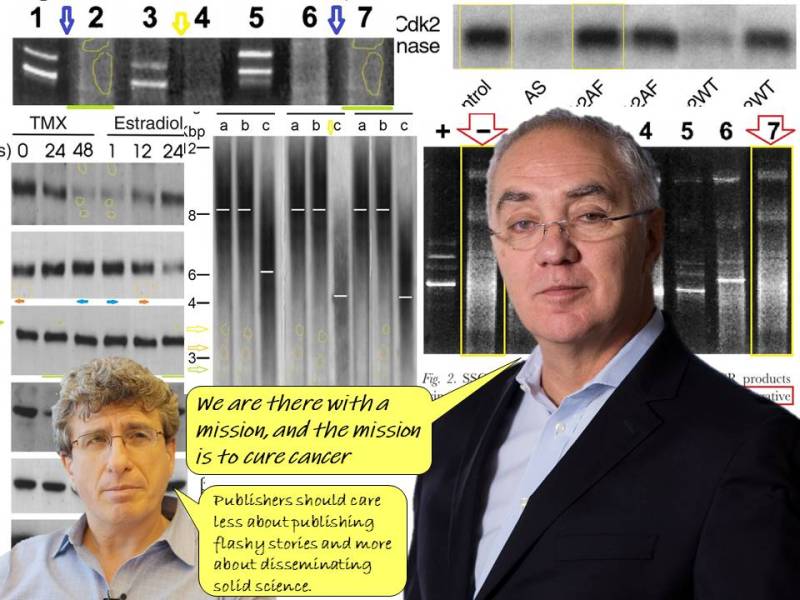

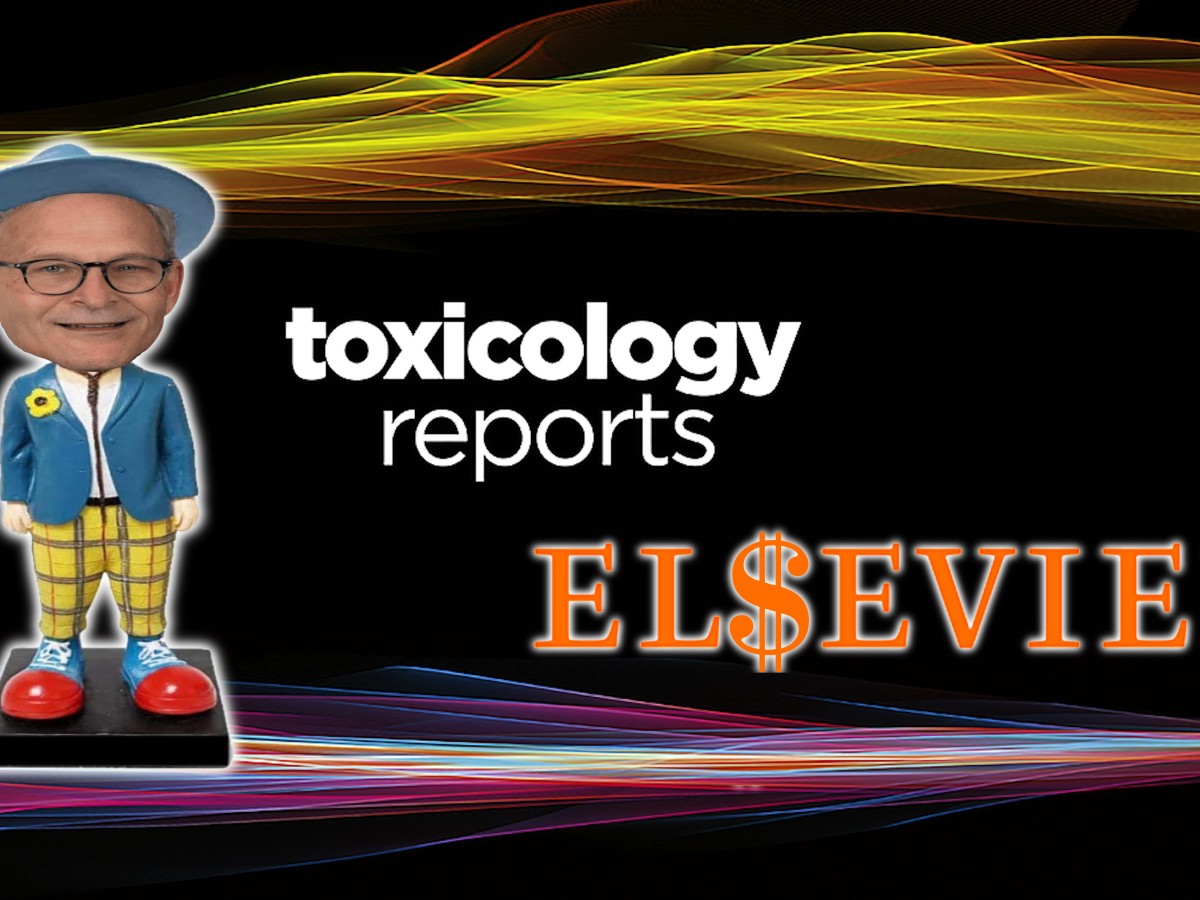

I’m pretty sure the perpetrator of the laptop thefts is the Hamburgler… although I don’t know how to embed images on this site.
https://www.timidfutures.com/2017/09/all-hail-the-hamburglar-1970-1980s/hamburglar-2/
LikeLike
Szunerits’ command of the English language is astonishing.
LikeLike
I wonder how strange it must be to try and conduct research on micro RNAs or long non coding RNAs. How can anyone keep to to date with the literature 😂
LikeLike